A perfect autumn day date
Miss Kitty gets her Tomcat 'whisky frisky,' goes window shopping
More than pumpkin beer
A look at the region's fall brews and cider
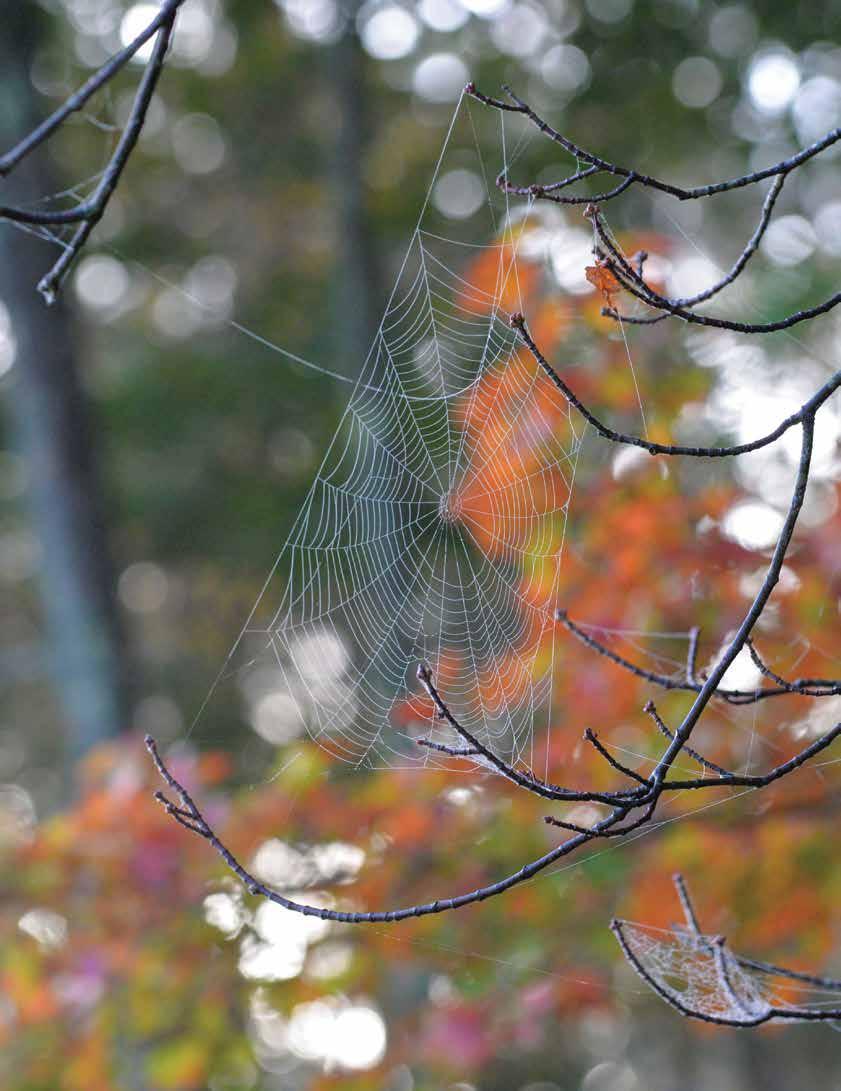
Another kind of leaf
Know your local pot shops
Fall Adventures in Southern Vermont September/October 2023 CustomerComplimentary$4.99 Copy


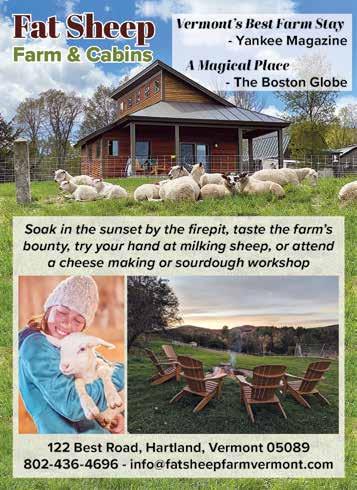
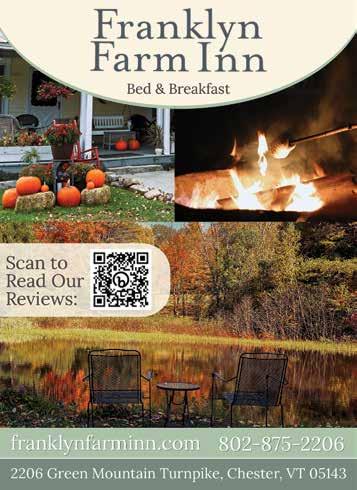



Michael Albans fancies himself a Brooklyn ruffian but is really a Pee Wee Herman and Barney mashup with a bad attitude. Mike takes nice photos and writes about most anything besides the outdoors or clothing trends. He has no friends but loves his wife.

Bob Audette is a cranky old white guy experiencing the world anew under the tutelage of an 11-year-old forest sprite. He’s been writing for the Brattleboro Reformer for nearly two decades.


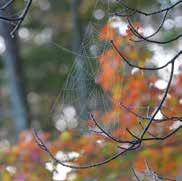
Alexander Belogour lives in Guilford, Vt., and is studying economics in his sophomore year at Keene State College. He considers himself an outdoorsman and likes to work with his hands despite the brunt of his time being spent in school. He does, however, love to write for the Brattleboro Reformer.
Jennifer Brandt is a born and raised Vermonter and a recent Brooklyn transplant. She has worked as a freelance writer and event coordinator for the past decade focusing on food and intersection with social justice issues. She has combined her passion for food and sustainable food systems with her Indigenous heritage by creating a series with MOFAD celebrating North American Indigenous folks in the food world. When not touring cities and the back roads of the Vermont countryside in search of the endless array of food and culture, you can find her taking Instagram photos of her rescue pup Bagel.
Stewart Cairns is a photographer for the Bennington Banner. Growing up in the NYC suburbs, he didn’t make it to the mountains much as a kid, but when he was 8, his family visited the Adirondacks, and he was convinced that he photographed Bigfoot. He was certain that the picture would be in the newspaper, and that he would be famous. His parents broke the news to him that he actually photographed a very hairy man who was renting the cabin next door, searching for firewood. He was disappointed but undaunted. He has photographed many barely believable things over the years, and now that he roams Route 7 throughout Vermont, he always keeps his gaze focused deep into the woods … just in case.
Gordon Dossett traded the traffic and urban ugliness of Los Angeles for the Green Mountains. He lives with his teenaged children, a cat and a dog, packing urban sprawl into one home.
Kathleen Hawes, aka "Miss Kitty,” is a creative writer who enjoys morning cocktails and holding grudges. You can read her work in The Sun Magazine, The Massachusetts Review, and other rando publications.

Katharine A. Jameson, still living in the urban sprawl of Los Angeles, is originally from Vermont. She returns with her children as often as she can and enjoys yachting in an inflatable rowboat in the pond at her childhood home. She writes a bimonthly food and health column for Vermont News & Media called “Food For Thought with Kat.” She regularly rails against Big Food and advocates for simpler ingredients on various television programs and offers some healthy (but tasty) recipes on Instagram @foodforthoughtwithkat.
Robyn Jensen is a young whippersnapper who spends all her time on that dang phone. On the brief occasions that she gets off it, she works as a freelance writer with interests in media and theater.

Gena Mangiaratti, whose first name rhymes with "henna," is arts and entertainment editor for Vermont News & Media. Halloween is her favorite holiday, but her costume game peaked in kindergarten. She lives in Brattleboro with her cat, Theodora, who can be followed on the platform she still calls Twitter, @fedoratheodora.

Chris Mays is a reporter for the Brattleboro Reformer. He plays guitar in three groups and has a Yorkie named Lemon, who can be followed on Instagram @lemon_the_yorkie. He enjoys spending time in the mountains and etching blankets on Saturday mornings.



Kristopher Radder is a photojournalist for the Brattleboro Reformer for eight years. Not much into pumpkin spice, but his hair color could match the season. A huge fan of the fall and the cooler temperatures it brings.
Tory Rich joined the Manchester Journal in September. Though he went to high school in Bennington, 10 years living in the desert has him relearning how to be a Vermonter the right way.

Dan Tebo is a Boston-based film critic whose work regularly appears on his mother’s refrigerator. He works as a waiter and amateur archivist and runs a VHS blog with a readership in the high single digits.
President and Publisher
Jordan Brechenser
jbrechenser@reformer.com

Editor
Gena Mangiaratti
gmangiaratti@reformer.com
Windham County Sales Manager

Lylah Wright
lwright@reformer.com
Senior Sales Executive
Richard Lolatte
rlolatte@reformer.com
Sales Executives
Richard Battista rbattista@reformer.com

Bruce Merrill
bmerrill@reformer.com
Bennington County
Sales Manager
Susan Plaisance splaisance @benningtonbanner.com


Sales Executive
Ahmad Yassir ayassir @benningtonbanner.com
Vermont
is a
CONTRIBUTORS On the cover:
Country magazine
publication of
vermontcountry.com | 3
Photo by Kristopher Radder.
Let's go spooky season! And beer.
By Gena Mangiaratti Vermont Country

It's my favorite season!! OK, not yet, but hopefully it will be by the time you read this. Anyone else get ragey when it's still 80 degrees in October? And I say this as someone who is perpetually cold. Seasons are meant to change.
Fall is, or should be, when the temperature is perfect (with maybe a sweater — see Miss Kitty's column for some guidance on a fall wardrobe shopping excursion), the bugs have gone back to the underworld, there is no snow to complicate things, and the timelessly pleasing scent of burning leaves is always in the distance.
But I think my favorite part is that it's officially "spooky season," the time of year that culminates with Halloween. It's like the winter holiday season, but better. Holiday cheer can feel forced, but seeing as life is inherently spooky and scary, nothing needs to be forced for the current season.
Leaning into real-life, local horror stories is "Haunted Vermont," now up at Bennington Museum. In this issue of Vermont Country, reporter Alexander Belogour and photographer Stewart Cairns take us inside the exhibition that includes possessions of the North Bennington resident and author Shirley Jackson, known for her contributions to gothic literature; "spirit art" from Solomon Jewett, a famous Vermont collector;
and original articles from the days of the Bennington Triangle disappearances. For more on the Bennington Triangle — Vermont's version of the Bermuda Triangle, also named for its disappearances — staffer Bob Audette has us covered with an interview with the fellow who coined the phrase.
Side note: Do you believe in ghosts? This is one of my favorite questions, going back at least as far as when I watched "Real Scary Stories" on the Family Channel in 2000. The show called for stories of real-life hauntings from then-youngsters like me, then filmed the investigations. To this day, I want to hear all tales of the paranormal (but I do prefer ghosts to demons). More on this later.
But for fictional scares, film columnist Dan Tebo is back with his take on a selection of creepy movies set in the woods. And since you can't have a scary movie without liquid courage, writer Gordon Dossett takes us through some fall beer options. If you're more of a cider drinker, staff writer Michael Albans shows us the inside of Little City Cider Co., a cidermaking operation right in Bennington.
If you plan to hit the farm stands, Vermont News & Media nutrition columnist Katharine A. Jameson and photographer Kristopher Radder take us to Harlow Farm in Westminster, and even give us a recipe using local produce.
Thrifters, collectors and reality TV-watchers: New Vermont Country contributor and thoughtful reviewer Robyn Jensen gives her take on "American Pickers," a History Channel show that visits antique collectors and negotiates for their treasures — and that is paying a trip to Vermont this fall.
Something else to look forward to is the sixth annual New England Street Food Festival, in its new, bigger iteration on the Brattleboro Common. Staffer Chris Mays tells us what's in store. In North Bennington, I take us inside the process of papermaker (I learned of this art form only when I did this story) Michelle Samour. And, of course, we celebrate the color green here in the Green Mountain State: writers Jennifer Brandt and
Tory Rich give a lowdown on some local cannabis operations.
Oh, and back to Miss Kitty: Our favorite frisky columnist is back with guidance on a perfect autumn day date in Southern Vermont. Fingers crossed that the season changes so we can, too. And if you have any local ghost sightings or your own "Real Scary Stories," hit me up at gmangiaratti@ reformer.com.
Gena Mangiaratti, whose first name rhymes with "henna," is editor of Vermont Country magazine and arts & entertainment editor for Vermont News & Media. Her style is still influenced by Samara Morgan from "The Ring." In addition to liking ghosts, she also really likes cats. She lives with hers (cat for sure, but possibly the former as well), Theodora, in Brattleboro.
EDITOR’S NOTE
Gena Mangiaratti — Vermont Country The author channeling that mirror shot from the cursed video tape in "The Ring."
4 | VERMONT COUNTRY MAGAZINE | SEPTEMBER/OCTOBER 2023
7 10 22
'American Pickers' hits Vermont
 By Robyn Jensen
By Robyn Jensen
3 4 14 19
Contributors Editor's Note
By Gena Mangiaratti
Spirit Art: Museum hosts 'Haunted Vermont' exhibit
By Alexander Belogour
Hard cider company brings new recipes to historic beverage
By Michael Albans
Food for Thought with Kat: Farm stand life
By Katharine A. Jameson
Beer me! Fall into local spots
 By Gordon Dossett
By Gordon Dossett
Street Food Festival moves to town common
By Chris Mays
Miss Kitty's guide to autumnal romance in Vermont
By Miss Kitty
Vermont Country Homes
Bennington Triangle: The haunting of Glastenbury Mountain

 By Bob Audette
By Bob Audette
40 47 54
From Green Mountain Cannabis News: Your local pot shops
By Jennifer Brandt and Tory Rich
Paper like we've never seen before
By Gena Mangiaratti
44 25 29 33
Ten tales of woodsy terror on the screen
By Dan Tebo
TABLE OF CONTENTS
vermontcountry.com | 5



'American Pickers' hits Vermont
What's it like to get 'picked' — and at what cost?
By Robyn Jensen Vermont Country correspondent
'American Pickers', a History Channel reality show in which the hosts visit antique collectors and negotiate for pieces from their collections, made a call to Vermont collectors for a visit to the Green Mountain State this fall.

"If you or someone you know has a unique item, story to tell, and is ready to sell…we would love to hear from you!" read a call for contestants."
What might getting "picked" look like — and feel like — for a reticent collector?
'American Pickers' is hosted by Mike Wolfe and a variety of cohosts. The show follows them around the U.S., meeting collectors and negotiating for pieces of their collection to sell at branded antiques stores. This year marks the fourth time the show has visited Vermont.
Season 11, episode 3, the first time that the Pickers visited Vermont, provides a typical model. Mike and his
cohost, Frank Fritz, are chatting on the road, when they get a call from their mission control, Danielle, directing them to a collector named Ken. The Pickers drive to Ken’s house and introduce themselves.
Ken has a lot of things that he’s interested in collecting, but our Pickers’ main interest is his bike collection. Ken first shows his large collections of normal bikes, but the Pickers are on the lookout for more unusual items. Slowly, they find them: an antique bicycle from one of the early companies
'American Pickers' is hosted by Mike Wolfe and a variety of cohosts.
vermontcountry.com | 7
Photo provided by American Pickers
to get into motorcycle manufacturing, and a stroller shaped like a Corvette from the 1955 World’s Fair.
As Ken tells the Pickers the stories behind these items, little infographics pop up, giving the viewer an extra look into the histories of those items. Then, the Pickers find the holy grail of the collection in a trailer off the beaten path: a life-size plaster Elvis statue. Some intense negotiation occurs between Ken and Mike, but eventually, the Pickers are able to get a good price for The King, and from there, the pick begins to wrap up, and the Pickers head out.
The show has been running for more than 20 seasons and 300 episodes. The main way it gets guests is by sending out requests for collectors who want to be visited by the hosts and a film crew. The show displays a pretty typical non-Vermont-resident understanding of what the state is like: beautiful, full of maple syrup and dairy, and rustic. The rustic part is of most interest to the show. In season 11, episode 10, host Mike Wolfe says that he loves picking the Northeast because, “If you want to buy old stuff, you have to go to an old place”.
That same episode features Mike talking to his cohost Frank Fritz about an idea that seems pretty clearly hammed up for the camera: What if Vermont, a place known for its dairy and its syrup, were to produce cheese-flavored syrup?
Every episode features banter back and forth between Mike and his co-host, most commonly Frank, so this dialogue isn’t particularly out of the ordinary, and the conversation is obviously framed in a way that makes Mike the butt of the joke, and yet it feels a little insulting to the state.
Unlike some of the other banter, this comes up when a collector, Dan, leads Mike and Frank into his sugar shack. Dan is a kind of old man that Vermonters will recognize easily: tough, sturdy, good at farming, and not good at talking. He is clearly out of his element with the very TV-charming Mike and cameras being shoved in his face.
Mike brings up his idea, which, again, is clearly a joke for the camera, to Dan. Dan, faced with the wicked, abominable thoughts forced upon him by the
presence of a film crew, turns to the fact that, from a purely logistical angle, cheese syrup feels impossible. Mike, mercifully, leaves the topic alone. This is not the only time throughout the episode that Dan seems uncomfortable. From the moment the hosts, and their cameras, drive up to his off-the-beaten path house, he seems on-edge.And as the hosts go through his collection, an element of the show that is often a little obscured comes into focus.
Dan has a very good sense of what his items would be worth to an interested collector, and tries to stick to that price with the Pickers. However, the Pickers aren't interested collectors; they are selling to interested collectors, and they need to make a profit on what they are selling. And so they need to buy it for less than market value. This is clearly something Dan is uncomfortable with.
Eventually, an easier rapport is found, and the show resumes its normal cadence of the seller making the first offer, then the Pickers, and so on until a number is found that both can agree on. But tensions start to rise again when Dan shows the Pickers one of his prize possessions, a massive, classic advertising board for the greatest soda of all time, Moxie. Mike, when he sees that, wants it. Dan is not interested in selling, but you can see him get tripped up a bit. Mike is a very shrewd negotiator, and Dan is not.
Luckily, Dan holds strong, but watching the episode, it is very easy to imagine an alternate world where Mike is just a little more aggressive, and Dan is just a little more unsteady, and the Pickers leave their pick with one of Dan’s prized possessions. This should be a cautionary tale to people interested in selling on the show.
In a talking head, Dan says, “I mainly just brought Mike and Frank in there to show them that I had some nice stuff, and it isn’t all for sale.”
The idea of getting your collection broadcast on national television, immortalized in a way, is very tempting, but in the end, the show is about people who purchase antiques, and then sell them at antique stores for a profit. If you have something that you don’t want to sell, you should be prepared to hold your ground.
The best example of the good the show can do comes in season 20, episode 3. This episode features the Pickers going up to Hartland to visit the Franklin Museum of Nature and Human Spirit, a collection put together by the late Edwin Battison. Battison was a collector and inventor of machinery, precision equipment, and the stories of the people who worked on them. He amassed a massive collection in his time, and even curated for the Smithsonian. He has a team dedicated to keeping his spirit alive, and as a collector, his spirit is in his collection. The Franklin Museum, now also called the Battison Museum, is operated by a team led by Jay Boeri, with whom the Pickers met on their visit. He told Valley News in an interview in 2019 after the episode was filmed, “The purpose of the publicity, we’re not trying to make money, we’re trying to get the story out.”
In the end, there aren’t that many opportunities for Vermonters to see themselves on the TV screen. The show tries to give itself a backing of history, in fitting with the brand of the channel, but you aren’t going to be getting deep dives into the nitty gritty of how these parts were actually made. It's entertainment, first and foremost. But, from all indications, it seems to treat its collectors pretty well, and for those at home, it’s a chance to see the faces from a place that “mass media” doesn’t often visit. And that’s worth something.
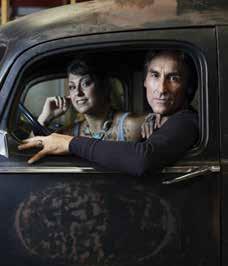
8 | VERMONT COUNTRY MAGAZINE | SEPTEMBER/OCTOBER 2023
Photo provided by American Pickers 'American Pickers' is hosted by Mike Wolfe and a variety of cohosts, including Danielle Colby.
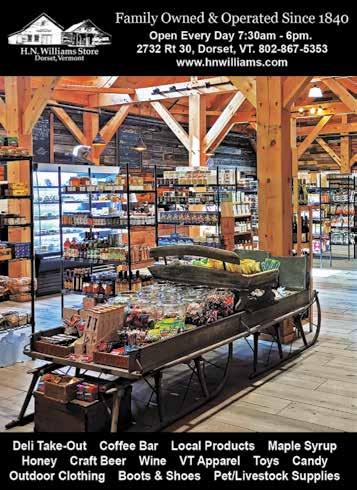
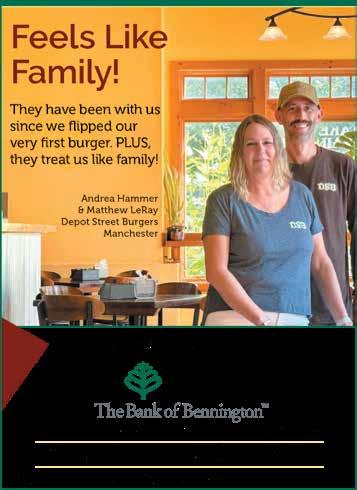

Spirit art, Shirley Jackson and witches haunting Bennington
Museum hosts ‘Haunted Vermont’ exhibit
By Alexander Belogour Vermont Country
BENNINGTON — A spooky exhibition featuring spirit photographs, original accounts of disappearances in the Bennington Triangle and letters about “demon vampires” in Manchester and witches in Pownal is on display at the Bennington Museum through Dec. 31.

“Haunted Vermont” was long in the works by curator Jamie Franklin. Much of the inspiration for the exhibition came from the late North Bennington resident Shirley Jackson, who, in the mid-20th century, was world-renowned for her contributions to the literary genres of horror and gothic.
“All of the Jackson material in the show was donated and, in some ways, was kind of the inspiration behind everything here,” said Franklin.
In 2021, Jackson’s eldest son, Laurence Jackson Hyman, contacted Franklin, wanting to donate some of his mother’s possessions to the museum. Some of the items the museum received were first-edition presentational leather-bound copies of Jackson’s books and newer inscribed editions from the 1970s. Other items donated were Jackson’s music box, which she claimed would play music by itself, and an old family table where in the last five years of her life, she typed her last novel, “We Have Always Lived in the Castle.”
“I’ve always had an interest in the general field of hauntings, but with the addition and opportunity of Jackson’s belongings, all of these stories I’ve known about, been interested in and have gathered over the years started to gel in my head; it took a while to get to this place, but once things started to happen, it all made sense to me.”
One of the other haunted sections focuses on spiritualism in Vermont. Most of the objects here are borrowed from the Henry Sheldon Museum in Middlebury. Objects include photos collected by Solomon Jewett, a famous Vermont-based collector, original Pulp magazine articles from the days of the Bennington Triangle disappearances and a handkerchief on which a spirit had allegedly written: “Mother, I am here.”
“Spirit art is, broadly speaking, any sort of artistic product that was the result of an interaction between a spiritual medium,” Franklin said.
10 | VERMONT COUNTRY MAGAZINE | SEPTEMBER/OCTOBER 2023
Stewart Cairns — Vermont Country Jamie Franklin, curator of the Bennington Museum, shows items in the upcoming "Haunted Vermont" exhibition at the museum. This example of "spirit art" depicts the wife of Solomon Jewett and talks about the healing powers of Jewett, a spiritualist.
Jewett had photos of himself with various spiritual entities, and he also collected art by the Andersons, a couple who claimed to be mediums in the 19th century, Franklin said.
“Solomon Jewett was also a spiritual healer. He was said to be able to heal people by putting his hands on them. There’s even one account where he claimed to have brought someone back from the dead.”
The exhibition also contains a poem gifted to Jewett that was said to have been written through a medium in the summer of 1858.
“William Mumler of Boston was believed to be the first person to allegedly take a photo of a spirit. Spirit photographs were extremely popular. A lot of them were proven to be false — being double negatives or double exposures, but people were heavily into spiritualism, especially right after the Civil War when many had lost loved ones. It was then that style of photography took off.”
When asked if the museum will have any special event for Halloween, Franklin mentioned a partnership program he will host with the Bennington Historical Society, in which he will join Laurence Jackson Hyman for a talk surrounding his mother’s legacy. Franklin will also be leading a gravestone tour in Manchester, where he will take an audience to Factory Point Cemetery and tell the story of the “demon vampire” Rachel Harris Burton, who was exhumed and burned in 1793.
“We do have the original manuscript that was written in the mid-19th
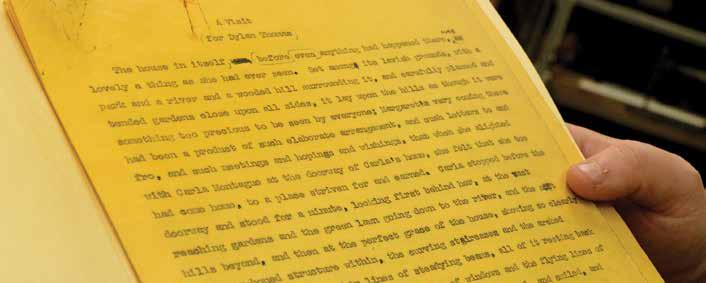
Stewart Cairns — Vermont Country
Top: Author Shirley Jackson, who lived in North Bennington, is central to the exhibition. Franklin holds an original document by Jackson.
Above: This example of "spirit photography," which sought to capture the images of spirits, will be part of the upcoming "Haunted Vermont" exhibition at the museum. Solomon Jewett is pictured at left.
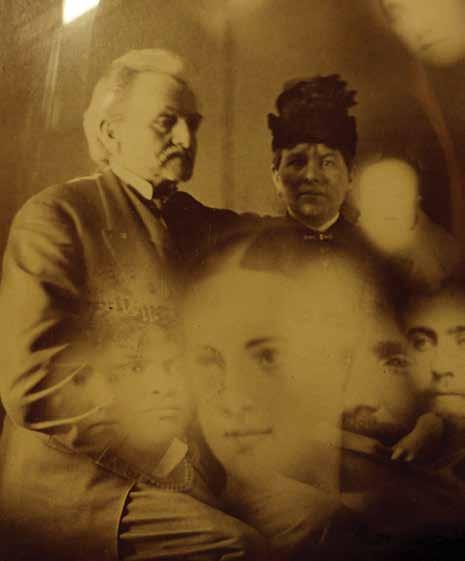
vermontcountry.com | 11
Clockwise from top left: This example of spirit art will be part of the upcoming exhibit at the museum.
Franklin is seen reflected in a "spirit portrait selfie station," which allows museum visitors to make their own spirit photography in the form of selfies.
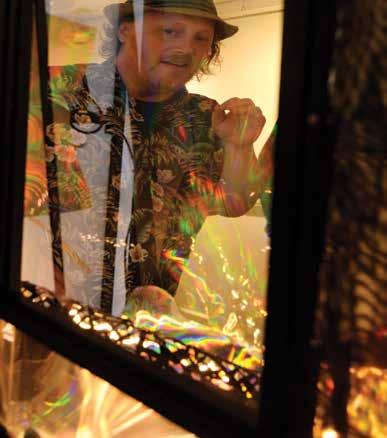
This spirit photography technique is "tintype" printing on which the image is laid onto a thin piece of metal. The ghostly images were painted on afterwards.

century by Judge John S. Pettibone in which he recalled the story of the demon vampire,” Franklin said. “We’ll also tell the story of Vermont’s only known witch trial in Pownal. There are only two historic documents that tell the story. One is a mid-19th-century story told by William Brownell, who was a Pownal historian. He stated that the witch was the widow of Julius Kreiger, one of the first Dutch settlers in the area.
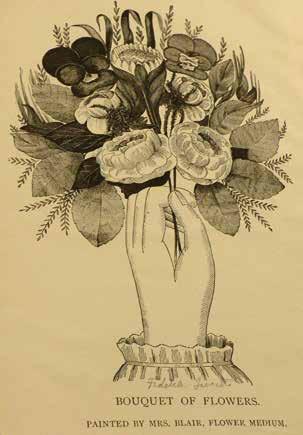
He died in 1785, and Mrs. Krieger died in 1790, so the trial took place sometime in between those years.” Also on display will be postcards that capture a “Haunted Bridge” once behind the Walmart in Bennington. Allegedly, locals would hear the sound of a phantom horseman galloping atop the wooden floor of the covered bridge. Screams and moans would also be heard, noted Franklin.
“Whether you believe in spirit pho -
tographs, ghosts and haunted objects is not the point of this exhibition. These are all real, local historical stories, and this is just another angle to tell them through.”
Franklin identifies as a huge fan of Shirley Jackson.
“We have original letters she wrote. As a curator, I’m always trying to tell interesting stories, and here, it’s always about local history: The connections she had to the area are amazing.”
Stewart Cairns
Vermont Country
12 | VERMONT COUNTRY MAGAZINE | SEPTEMBER/OCTOBER 2023



Southern Vermont hard cider company brings new recipes to a historic New England beverage
 By Michael Albans Vermont Country
By Michael Albans Vermont Country
BENNINGTON — The first recorded reference to cider dates back to Roman times. Julius Caesar discovered Celtic Britons fermenting cider from native crabapples, and in northern Spain, farmers fermented apples before the birth of Christ.
In Colonial America, cider was the most commonly consumed beverage, even more than water, which was considered risky. Pressing and fermenting fresh apple juice was the easiest way to preserve a large fruit harvest that the first colonial Americans planted. In rural communities, taxes, wages and tithes were often paid in cider.
By the late 1800s, cider began its
steady decline. Several unrelated forces combined to wipe cider from the collective memory of America. A significant factor was the Industrial Revolution, bringing people from the farm to the city to live and work. Many orchards were abandoned, resulting in drastically reduced production. Unfiltered and unpasteurized cider did not travel well from farms to the new population centers. An additional element was the increased consumption of beer, especially in cities. Immigrants arriving from Germany and Ireland and cheap grain in the Midwest led beer to replace cider in the marketplace.
By the time Prohibition was enacted in 1919, the production of cider in the U.S. had substantially slipped. The once proud American tradition of cider mak-
ing was kept alive by a few local farmers and enthusiasts. In recent years, there has been a resurgent interest in cider making, and today, cider is one of the fastest growing segments of the liquor industry. Enter Little City Cider Co. in Bennington, dedicated to preserving and growing the tradition of New England cider through recipes lovingly curated by its owner, Greg Videtto.
“Well, I was always very interested in distillation,” says Greg as we sit inside his Bennington tasting room. “I had my first drink at 21 years old at Madison Brewing Company, and I always loved all the equipment. I guess I saw the trends with cider growing and had a little background with some cider, so I figured it was time. I’d been thinking about it for a long time.”
14 | VERMONT COUNTRY MAGAZINE | SEPTEMBER/OCTOBER 2023
Michael Albans — Vermont Country Little City Cider now has up to eight different flavors. Greg Videtto also plans on producing seasonal offerings in the near future when time allows.
“We're definitely not a big corporation. I've worked my butt off for 23 years and, pretty much at this point spent every dime I have to try to make this work because I see the growth and it's working. There's quite a bit of a one-man show going on here," says Greg Videtto.
Greg spent 23 years owning a company called New England Custom Timber Frames, building custom homes from Vermont up to Martha's Vineyard. The company had just started a big project when COVID hit, and the project fell out from underneath them. After giving the idea some thought and talking with some trusted family members and friends, Greg made the daring decision to move forward with his idea to have a hard cider company.
“This been seriously festering for probably about a year before COVID,” Greg says. “It was a kick in the butt, too, because when we finally kicked
it off to go for it, we ended up getting stalled just like everybody else.”
Greg found a vacant building in Bennington that had been empty for about seven years, originally housing Vermont Composites. It’s about 55,000 square feet, with Little City Cider occupying about 1,000 square feet. That’s where his passion for cider and his experimentation with flavors began. Because of COVID, there were several delays in receiving equipment and supplies, especially his fermenting tanks from overseas, but that just gave him more time to perfect his cider recipes.
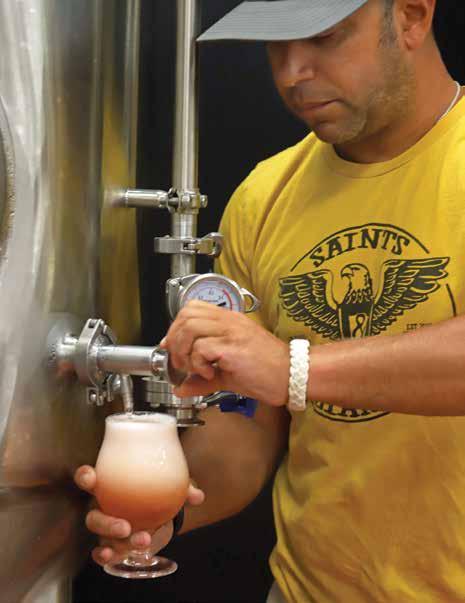
“COVID definitely made us pump
the brakes a lot,” he says. “A lot of the equipment we needed ended up getting stalled. Some of the equipment was from Italy. Some of it from Germany. Some of it I got was lightly used, but we still needed a lot of parts and pieces. Moving forward, once we finally had everything we needed, we got put behind right off the bat because we couldn't even get the apples or the juice we needed. Nobody had enough help to pick apples. They didn't have enough help to press juice. That created a little bit of a problem.”
Little City Cider presses small amounts of apples in-house for some of its upcoming seasonal reserve cider, mostly for the fall, and receives some of its “juice” from a specialty company out of Brattleboro. The rest of its press juice, like most small and large cider companies, comes from a company in Massachusetts. During COVID, getting raw materials was a daunting task. Greg made the best of the time by perfecting the uniqueness of his ciders. “It was probably about a year and a half making just one-to-five-gallon batches at the house at first and trying different flavors," he said. “When we actually got fired up with this place and received our equipment, I was delighted to find that using the professional equipment was much easier and cleaner. Also, having the appropriate floor space and the drains and everything in the pumps at the new space, was great. We went from five-gallon batches to 150 to 700 gallons at a time. It was crazy.”
The Little Cider Company is currently distributed throughout Vermont, with 70 accounts, the biggest being Price Chopper. They are currently in the process of going to Massachusetts and hope to spread their cider throughout New England.
“We're definitely not a big corporation. I've worked my butt off for 23 years and, pretty much at this point spent every dime I have to try to make this work because I see the growth and it's working. There's quite a bit of a one-man show going on here. We have a lot of volunteers that help us with our summer concerts and stuff like that. We partnered with the Vermont Arts Exchange for a concert series that's pretty much in the winter as well. We have a really diverse crowd, and everybody's very respectful. They're happy that we have a venue like this in Southern Vermont, specifically here in
Michael Albans — Vermont Country
vermontcountry.com | 15
Bennington, with this type of atmosphere and making spirits, alcohol, cider and music. It's a passion. I've always felt Vermont was a special place. I feel like people come here for a reason. Vermont itself has its own brand. I love Vermont. It's been a huge part of my life.”
What’s really important to Greg, however, is the cider. Greg is protective of his recipe for good reason — it’s unique, a kind of champagne-type cider, semi-dry to dry, due to his use of champagne, ale and wine yeasts.
“A lot of cider is really sweet,” Greg says, “I went down the road of semidry to dry. And I was very happy to find out people liked it. People who tried it were like, ‘Wow, this is nice. It's not so sweet. I can drink a few of them' or, you know, 'it's not making my face pucker.’ Some of my friends that are hardcore craft beer drinkers love a cider called ‘Hopped Up.’ We infuse two different types of hops into it. They like that. It was a good twist for us.”
Little City Cider produces several other versions of cider as well. It now has up to eight different flavors. Videtto also plan on producing seasonal offerings in the near future when time allows.
“In the fall, we do one that's called Seasonal Vibe. That's a cinnamon, nutmeg, clove-infused cider. We also have a new release coming soon, which I don't want to talk about too much because it's going to be a surprise, but it will be probably the one sweet offering in our lineup.”
When pressed on details, Greg smiles and says, “So in Vermont, and just over the border in New York, we have a lot of different fall festivals, carnivals and fairs. It will kind of go down the lines of something that would be at those fairgrounds.”
I asked Greg to take me through the process of making hard cider, from delivery of the raw juice to filling up the cans and kegs for his tasting room. He said it all starts by suspending the apple’s natural fermentation process so it can be controlled.
“As soon as we get that juice, we suspend the natural yeast that's an apple so that it doesn't start fermenting on its own. That allows me to add whatever type of yeast I would like to use to help ferment. Quite a few of our recipes have different yeasts. A lot of companies use cider-based yeast. I don’t. I use all champagne, wine or ale yeast for the majority of our ciders. The goal is to replace it so that you add what you want it to taste like. Champagne yeast will dry it out pretty good. Some of these other ale and wine yeasts I use have a nice finish.”
It takes about 48 hours to suspend the yeast, producing about 6% alcohol within a couple of weeks. The whole process, from start to finish, takes 60 to 90 days.
“Cider is very different than beer. We skip the whole boiling process. Cider is ultimately a wine. We basically have a wine license to make cider. Cider is very much like wine in the sense the longer it sits, the longer it ages. Maybe not everybody that makes hard cider would agree with me on that, but you know, it
Videtto points to one of the giant vats lined up across the back wall of his tasting room. Each tank funnels down into an upside-down cone. He says the shape of the tank allows him to remove the unwanted particles without losing flavor or color. The apples and juice have already been pasteurized, avoiding unwanted elements in the cider.
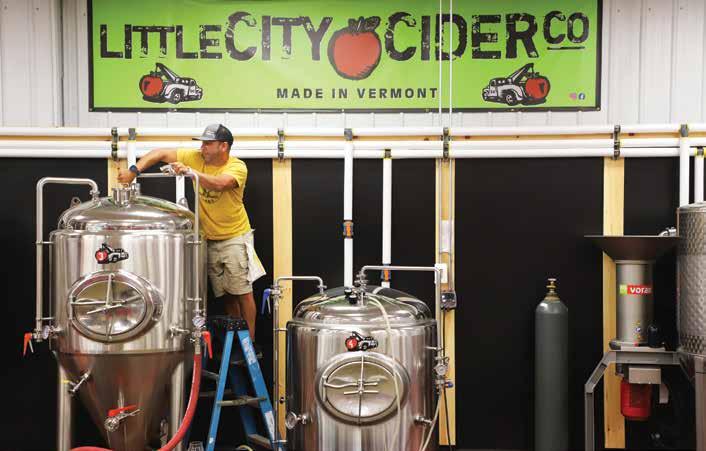 Michael Albans — Vermont Country
Michael Albans — Vermont Country
16 | VERMONT COUNTRY MAGAZINE | SEPTEMBER/OCTOBER 2023
usually smooths out, and it also clarifies it. People say, ‘Oh my goodness, this looks so clear. You must filter it.’ Our ciders are unfiltered, but because of our process, it naturally cleanses itself by settling the suspended particles over 60 to 90 days in the tank.”
Greg points to one of the giant vats lined up across the back wall of his tasting room. Each tank funnels down into an upside-down cone. He says the shape of the tank allows him to remove the unwanted particles without losing flavor or color. The apples and juice have already been pasteurized, avoiding unwanted elements in the cider.
“When you look at cider and get one in a gallon jug, that's just normal cider. It's brown, right? That's what the juice looks like when I get it. It's basically an oxidation. You cut an apple on your countertop, and you turn it on, wash your hands, and you come back, it's already starting to brown. It's an oxidation process. My semi-dry is as clear as a Chardonnay. The sediment goes down to the bottom of the tank, into those cones right there, that would be called a cone. We have a valve on that. I let it sit so it clarifies. These tanks are jacketed with glycol jackets so that I can control the temperature. My different recipes have different fermenting temperatures, as they do finish temperatures. Once we get to a certain point, and I get the sediment out of the bottom, when I close that valve, and I'm happy. You're looking for clarity that's fermenting all this time. It gets to the point where you are happy with both the clarity and the alcohol content.
"We then chill it down to, say, 34 to 35 degrees. That also helps clarify because that will drop that last little bit of sediment out.”
“From that point, we'll carbonate the cold, chilled, clarified product in the fermenter. Almost every one of these fermenters can do the whole process. Depending on the recipe, there’s more or less carbonation. Once it's carbonated, I add fresh press purees out of California. That's where the flavor comes from. It takes 60 to 90 days for the process — from apple juice to drinking at our tasting room.”
Little City Cider Co. looks forward to distributing its cider throughout New England but wants to remain close to its roots.
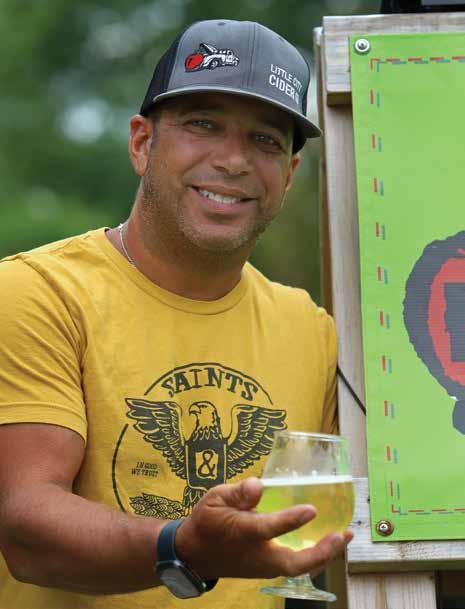
“I don't see it getting too big. I like the
Greg Videtto found a vacant building in Bennington that had been empty for about seven years, originally housing Vermont Composites. It’s about 55,000 square feet, with Little City Cider occupying about 1,000 square feet. That’s where his passion for cider and his experimentation with flavors began.
Vermont roots thing. I see potential growth, needing bigger equipment and such. I mean, we already need bigger equipment. How big? I don't know. I'm trying to get this off the ground where maybe we feel comfortable getting bigger equipment down the road. We are small. It was a dream, and we're following it, and life's good and happy. It's good stress.”
Little City Cider Co. is at 139 Shields Drive in Bennington. It is open yearround, three days a week, Thursday, Friday and Saturday, from 5 p.m. till closing. The site hosts a concert series once or twice a month, and also hosts local musicians and
an open-mic night twice a month.
“Everybody has been very supportive of this. We are trying to create a venue space with what we have to share here and use it to have these events. Music is a huge passion of mine. I love music. That's my church. And I love being able to put on a show for people. There have been no problems. You don't come in here and see people all drunk. You see people enjoying themselves, listening to music and having a few cocktails.
“I am so very thankful for the support from the town and everyone.”
Michael Albans — Vermont Country
vermontcountry.com | 17
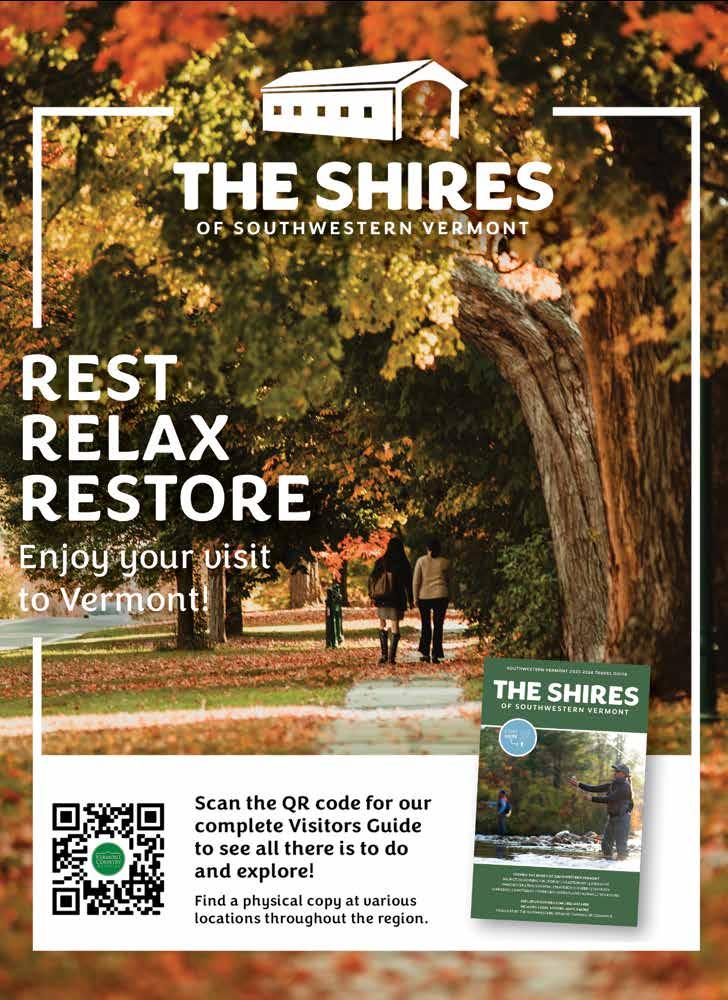
Farm stand life
By Katharine A. Jameson Vermont Country correspondent
Few things symbolize the arrival of summer here in Vermont more than the bounty of farm stands dotting local roads. We’re fortunate enough to see these stands replenished with seasonal fare throughout much of the fall and sometimes into the winter. One thing we take very seriously as Vermonters is our food — we not only focus on fare, but its quality, and you’ll find no better veggies than those grown at generations-owned Vermont farms.
Nearly 30 percent of Vermont farms are managed by farmers who are 65 or older. Most of these farmers work without a younger counterpart poised to one day take the helm.
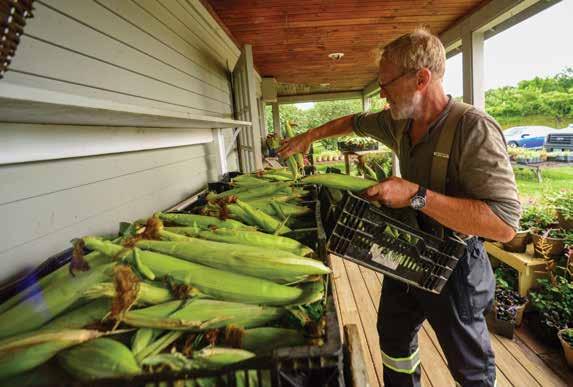
When I spoke with Dan Harlow of Harlow Farm in Westminster, he made one thing clear: “Don’t let your kids grow up
to be farmers.” Though it sounds like a lyric in a country song, his sentiments are real. Coming off of the recent flooding events, Harlow Farm lost at least three fields of crops. This year’s loss pales in comparison to that left in the wake of Tropical Storm Irene in 2011, which brought with it a million-dollar price tag.
“You want your kids to have an easier life. [Farming is] a difficult life and you’re certainly never going to get rich from it,” Dan explains.
Three generations
In 1917, Harlow’s grandfather bought the farm, where he grew vegetables and tobacco. Throughout the years, the farm saw new life as a dairy farm and then again as a vegetable farm. By the time Paul Harlow, Dan’s older brother, took over the farm in 1975, he had to address overworked soil that had seen decades of chemical fertilizers. “Paul said ‘we
have to do something different,’ the soil (didn’t) hold moisture,” Dan tells me. Paul and his wife, Susan, began farming organically, acre by acre. They omitted chemical fertilizers and returned organic matter to the soil. Cover crops with deep roots aided the soil’s recovery as well by restoring its nitrogen content. Field by field, the farm became certified organic. It was one of the first organic farms in New England, long before it became trendy, and remains one of the largest.
“Vermont is very strict,” Dan says about the certification process and maintaining organic standards. “You get a visit from them in the spring, which is scheduled. In the fall, it’s a surprise. They just show up and they’re there. They’ll go in your closets looking for pesticides or anything chemical. They’re very strict, which is nice. The one thing, especially for small growers,
FOR THOUGHT WITH KAT
FOOD
vermontcountry.com | 19
Kristopher Radder — Vermont Country Andrew Hogan, an employee at Harlow Farm Stand in Westminster, fills the racks with fresh ears of corn.
is that it’s expensive to get certified.” Today, the farm is home to what’s called Hadley soil, which Dan reports is some of the best soil in the world. “It’s the perfect combination of sand and clay and loam — it’s all old river bottom. There’s not a rock in anything. You can’t find a rock,” Dan says.
The proof is in the produce.
Farming is hard work, but the Harlows continue to honor family tradition on their 400-acre farm. “I love my job,” says Dan. He knows he’s providing a “really good service” by operating the family’s farm stand. I tell him the more I try to grow food myself, the more grateful I am that there are families like his that keep food on the shelves. The Harlows cater to locals and welcome visitors off I-91. “Once they stop by,” Dan says, “they keep coming back.” It’s hard not to keep returning to their bountiful produce, preserves and canned goods (we can attest to their pickles). They even have a café adjacent to their farm stand, which is open seasonally.
The floods were tough on the corn this year, blessing the crop with a nasty case of tip worm. “We weren’t able to treat the insects like we usually do.” Harlow describes how they use stinging wasps for pest control on things like tip worm rather than using sprays. “Because of the rain,” he continues, “the wasps were like, ‘we’re not flying in this’.”
“Paul’s really guru on all (this) stuff. He’s the farmer for sure,” Dan tells me. When choosing produce, Dan recommends looking at its quality and freshness. “Each thing has its own kind of telltale signs. I can look at a zucchini and know that that's a day old because the shine (has) gone off. I think that people have this weird concept that organic is dirty and bruised and it's not true, you know? I mean, there's beautiful organic produce available, it's just beautiful. I also think people should make more of an effort to support their local farmers.”
The Harlows have mastered the art of growing and one thing’s certain: Vermont’s home.
In season now at the farm stand: corn, watermelon and daikon radishes, lettuces, winter squash and kale. Harlow’s farm stand is open year-round on the weekends and all week long from April until December. It is in Westminster at 6365 Route 5.
Herbed ricotta crostini with watermelon radish

Ingredients
1 cup ricotta cheese
¼ cup basil
1 handful parsley, destemmed
1 tablespoon chives, chopped
½ teaspoon salt (or to taste)
¼ teaspoon pepper
1 tablespoon extra virgin olive oil (more for crisping garlic)
1 lemon, zested
2 teaspoons lemon juice
4 to 5 cloves garlic, peeled (set
2 aside to slice)
1 fresh baguette, sliced
1 large watermelon radish, sliced and quartered (from Harlow Farm!)
¼ cup microgreens, for garnish
Method
Preheat oven to 275°F.
In a food processor, combine ricotta, basil, parsley, chives, salt, pepper, olive oil, lemon zest, lemon juice, and 2 to 3 cloves of garlic (set 2 cloves aside). Pulse or puree until smooth. Taste for seasoning.
Place sliced pieces of baguette onto baking tin. Place in oven to toast, about 7 to 9 minutes.
While the bread is toasting, heat remaining olive oil in a cast iron skillet. Add sliced garlic to pan, stirring and flipping frequently. Brown and remove, placing on paper towel to drain.
Assemble toasts by spreading with ricotta mixture, topping with crisped garlic, watermelon radish and microgreens. Serve while still fresh from the kitchen!
20 | VERMONT COUNTRY MAGAZINE | SEPTEMBER/OCTOBER 2023
Katharine Jameson — Vermont Country correspondent This herbed ricotta crostini uses watermelon radish from Harlow Farm in Westminster.
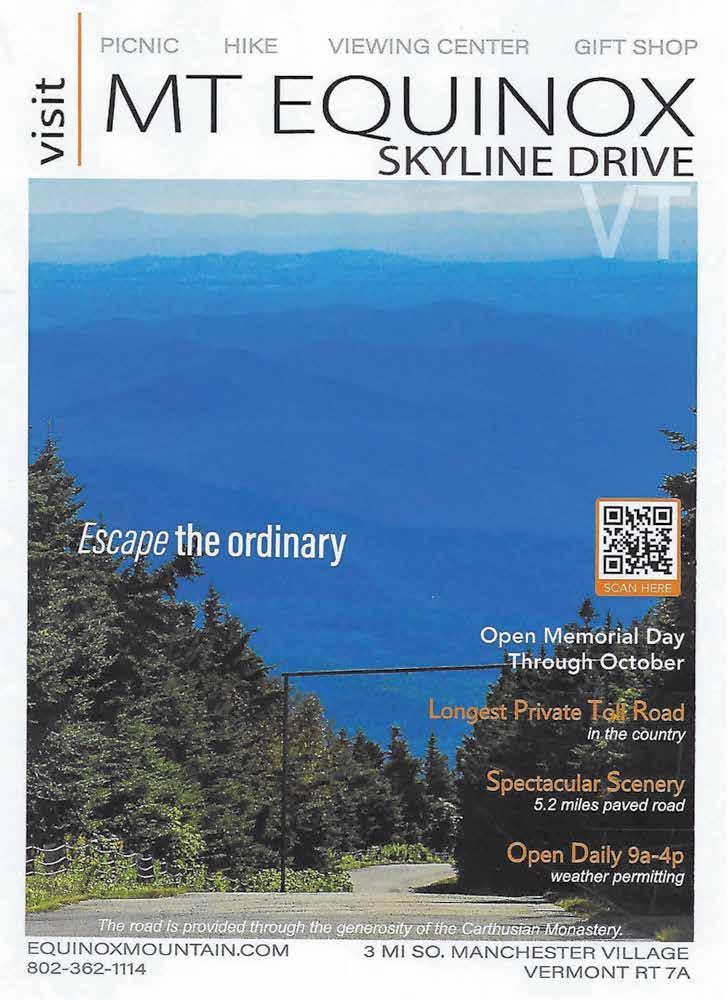
Beer me!
Fall into local spots
By Gordon Dossett Vermont Country
MANCHESTER — We in the Northshire must admit: If Vermont relied on us for its reputation for craft beer, we’d be, well, crying in our beer. The state’s craft brewery with the greatest reputation — Hill Farmstead Brewery — lies tucked far away in the Northeast Kingdom and sells its beer in only one place in Southern Vermont (Brattleboro).
Locals are hopeful, though. A craft brewery should be sprouting up smack dab in Manchester Center, in front of the Hampton Inn, eventually to brew 20 barrels of beer per week — enough to quench a few thirsts.
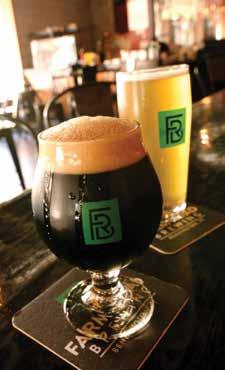
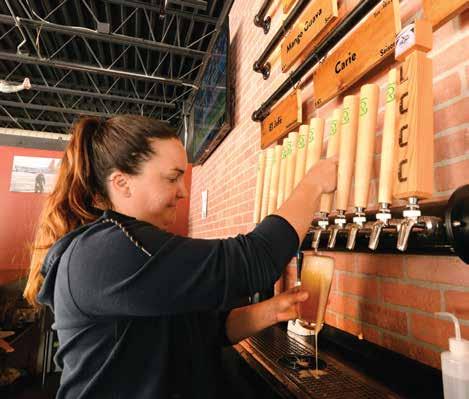
But not until 2024.
For this fall season, we have to look elsewhere.
If you’re in search of Oktoberfest, you could wing yourself off to Munich — but show up in October and you will have missed most of it: the festival runs from Sept. 16 through Oct. 3.
Traditionally, Oktoberfest beers were Märzen Lagers (literally March beers, brewed in March). The reason for this March/Oktober confluence is anchored in history. Germans were prohibited from brewing beer commercially from late April until September (largely to prevent contamination of beer, since there was no reliable refrigeration centuries ago). For the first Oktoberfest, beer from March was available and, so, enjoyed — starting a tradition.
Since the 1990s, though, Germans at Oktoberfest have hoisted festbier, a yellow — not amber — ale, with a white head, light bitterness (IBU — explained below — under 25) and
alcohol around 6%.
We in the U.S. have stayed old-school (an opening for a craft brewery?).
For Oktoberfest, Vermont breweries send kegs to local establishments, but as of press time, we can’t tell you just which beers will be on tap where. Please scout this out yourself: Either march your lederhosen into various establishments (preferable), make phone calls (very-20th century) or check online (unpredictable and unquaffable).
The season, too, offers pumpkin spice ales to match the amber leaves as well as some brown ales.
Below are fall beers brewed in Vermont worth considering and places worth visiting.
Note: Alcohol by volume is self-explanatory; IBU (International Bitterness Unit) correlates to the amount
Stewart Cairns — Vermont Country Erin Miller, Tap Room Manager, and Assistant Brewer, pours the Mango Guava, which is on tap at Farm Road Brewing.
Stewart Cairns — Vermont Country
22 | VERMONT COUNTRY MAGAZINE | SEPTEMBER/OCTOBER 2023
The Black Pearl oatmeal stout, foreground, and the VT Helles lager are on tap at Farm Road Brewing in Bennington.
of hops used in brewing the beer. The lower the IBU (on a scale of 0 to 120+), the less bitterness or bite — at least in theory. When it comes to actual taste, IBUs are a guide and not a science; a dark beer such as an oatmeal stout may have a relatively high IBU and not have the bite of, say, an India Pale Ale. Märzens have lower IBUs and smoother taste profiles.
Oktoberfest beers
Queen City Brewing’s Oktoberfest
5.5% (IBU 30)
Stone Corral Brewing’s Oktoberfest
5.6%
Vermont Beer Makers Oktoberfest
Märzen 5.4%
von Trapp Brewing Oktoberfest
Lager 5.6% (IBU 30)
Zero Gravity Märzen 5.4% (IBU 26) zerogravitybeer.com/oktoberfest
14th Star Oktoberfest Märzen Lager
5.8% (IBU 22)
Other fall beers
Four Quarters Great Bear: Brown ale with chocolate malt, oats and smoked malt (6.0% alcohol), has a light-to-medium mouthfeel and a light bitter-hop edge.
Foley Brothers Brewing Double Maple Brown: Imperial brown ale brewed
with maple syrup (8.2% alcohol) — the maple syrup results in higher alcohol but not a sweeter taste. This beer, smooth, rich and full, pours with a thick tan head.
Long Trail Pumpkin Ale 5.5%, (IBU 22)
The Shed Brewery Pumpkin Ale 6.7% (IBU 25)
Places
Bronwyn-on-Battenkill: 5403 Route 7a, Arlington, VT 05250. Open Wednesdays through Sundays, varying hours. 802-430-7364. bronwynonbattenkill.com
Specializing in German food and boasting a beer garden, Bronwyn will celebrate its first Oktoberfest since opening earlier this year.
The Copper Grouse: at the Taconic Hotel 3835 Main St., Manchester Village, VT 05254. Open Thursdays through Mondays, 4:30 to 9 p.m.; Tuesdays and Wednesdays only for breakfast. 802-363-0176. coppergrouse.com
The bar usually gets two kegs of Zero Gravity’s Oktoberfest Märzen Lager — in September — and they’re gone by October.
The Crooked Ram: 4026 Main St., Manchester, VT 05254. Open Thursdays through Sundays, varying hours. 802-417- 5049. thecrookedramvt.com
Seasonal offerings likely from Schilling (like Konstantin, an Austrian-style Märzen); from Foam, a Burlington brewer; and Cave (aged wheat beer) from Wunderkammer, a brewer in the Northeast Kingdom. Beers from Urban Chestnut Company are scheduled to include: Stammtisch German Style Pilsner; Zwickel Bavarian Style Lager; and Dorfbier, a Munich Dunkel style beer.
Dorset Union Store: 31 Church St., Dorset, VT 05251. Open Tuesdays through Saturdays, 7:30 a.m. to 5 p.m. 802-867-4400. dorsetunionstore.com
A retail store, not a pub, which has an excellent selection of pumpkin ales, Oktoberfest beers, maple ambers, and various porters and stouts.
Farm Road Brewing: 400 Main St., Bennington, VT 05201. Open Wednesdays through Sundays, varying hours. 802-440-5121. farmroadbrewing.com
Harvest Brewing: 201 South St., Bennington, VT 05201. 802-430-9915. Open Thursdays through Sundays, varying hours. harvestbrewing.net
Madison Brewing: 428 Main St., Bennington, VT, 05201. Open Mondays through Sundays, varying hours. 802442-7397, madisonbrewingco.com
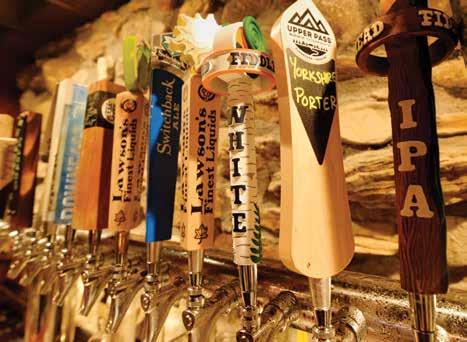
Meulemans’ Craft Draughts: 8814 VT-30, Rawsonville, VT 05155. 802-297-9333. Open Wednesdays through Sundays, varying hours. craftdraughts.com
Meulemans’ is not not a pub; it’s a retail beer store. However, it’s a wonder, tucked along Route 30 in the village of Rawsonville, part of the metropolis of Jamaica (population 1,005) — kept going by strong local support, skiers from Stratton and owner Greg Meulemans’ abiding passion for beer. Along with a strong European section, the store carries Oktoberfests from Burlington Beer Company, Zero Gravity, von Trapp and Black Flannel.
Smuttynose (OK — a New England, but not Vermont beer) makes a standout pumpkin beer with a cleaner, notso-spicy flavor profile.
Union Underground: 4928 Main St., Manchester Center, VT 05255. 802367-3951. Open Tuesdays through Sundays, varying hours. unionundergroundvt.com. Excellent selection of beers on tap.
Stewart Cairns — Vermont Country
vermontcountry.com | 23
The variety of the beers on tap at the Union Underground in Manchester.



Street Food Festival seeks to stuff Brattleboro Common
By Chris Mays Vermont Country
BRATTLEBORO — The sixth annual New England Street Food Festival is set to be more accessible and bigger than ever as it moves to the Brattleboro Common.
"We want to bring it downtown to help the businesses," said Bud Lolatte, advertising representative for the Reformer. "It's a more wide-
open space, which gives us flexibility for more things like bounce houses we're going to have this year for the kids. We're having a dunk tank. It gives us more room to be able to spread out because we have the whole Common."
The festival is happening rain or shine from noon to 5 p.m. Sept. 30. Also new this year are partnerships with the Brattleboro Buddy Walk and Que for a Cause.
Created by the Brattleboro Reformer with partners in 2017 and skipped in 2020 due to COVID, the festival is now in its sixth year. Previously, the event was held at Kampfires Campground in Dummerston.
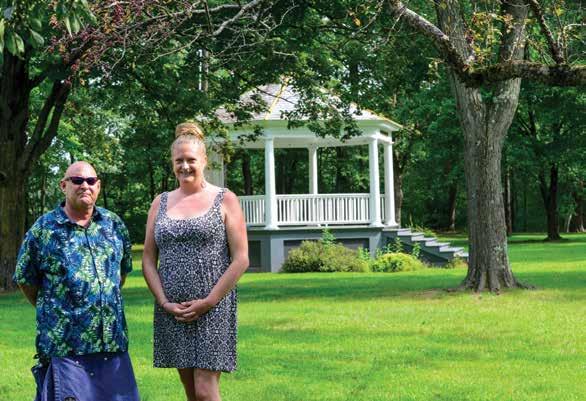
Meters at the Common will be bagged so the spaces can be used by those with mobility issues. Access had been a concern at the previous location.
Lolatte hopes to get 3,000 to 4,000
Kristopher Radder — Vermont Country
vermontcountry.com | 25
Richard “Bud” Lolatte, advertising representative for the Reformer, and Lylah Wright, office and advertising manager for the Reformer, on the Brattleboro Common, where the Street Food Festival will be held this year.
attendees who might go visit downtown businesses during the day. The partnership with Whetstone Beer Co., whose owners also own Kampfires, and Brattleboro Area Realty continues.
The sponsors were consulted before the move. They also wanted to see if the new spot would raise the event's visibility and make it easier for people to get to, Lolatte said.
Lolatte noted the "very picturesque" park and bandstand at the Common. "It's a nice visual," he said.
The decision also has to do with the town's recent ordinance change. With a valid liquor license, alcohol can now be served on the premises. Bounce houses and inflatable obstacle courses are coming thanks to Bounce Above the Rest. New England Center for Circus Arts will offer flying trapeze shows.
The second annual Que for a Cause, a barbecue contest to raise funds for Black Mountain Assisted Family Living, will "feature competitors cooking up a storm to try and take home the trophy and bragging rights," states bmafl.org/que. Lolatte said three judges will be eating the food.
"I’m grateful to be partnering up with
the New England Street Food Festival and the Buddy Walk for a day of mission driven fun on the Brattleboro Common," said Peter "Fish" Case, president of the Black Mountain Assisted Family Living Board. "Street Food vendors at one end, barbecue competition on the other, it will be a day of mouthwatering excitement for all that attend."
The Brattleboro Buddy Walk will start in the morning. The walk raises awareness about Down syndrome and funds to cover the expenses of the event and support Special Olympics programs in Windham County. To register, visit brattleborobuddywalk.org/register-for-buddy-walk.html.
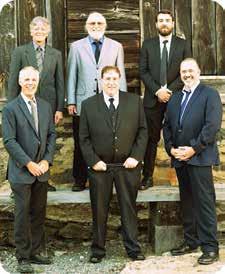
Lolatte said the partnership with Buddy Walk came about after he went to reserve the Common and found out the event was planned for the following weekend. He contacted organizers of Buddy Walk and Que for a Cause, and they decided combining forces would be mutually beneficial.
"It seemed like a good fit," Lolatte said. "Our goal is to have the Common full of event stuff between the food trucks, NECCA, Que for the Cause, the bouncy house, inflatables. It would be nice to have 90 percent of the Common covered, then we'll see what we draw. It will be all about the weather at that point."
With lots of tree cover, Lolatte said a light sprinkle shouldn't affect the festival fun.
Wyld Nightz, a local classic rock and roll band, is headlining. The band specifically selects songs that get crowds up and dancing. The band performed at the festival two years ago and as a trio at Buddy Walk a few years ago. Combining the events is "pretty cool," said Michael McKinney, lead guitar and trumpet player in Wyld Nightz. He described his band's repertoire as being "pretty wide and eclectic."
"We kind of lean on that," he said. One moment, the band might have
"We are super excited to host our annual Street Food Fest again this year. It was a tough decision to move its location to the Common downtown, but we felt this would make it more accessible and visible. Additionally, partnering with the Buddy Walk and Que for a Cause helps bring light to these local organizations, both with great purpose in our community. "
— Jordan
a banjo out and be playing bluegrass. The next, the musicians could be deep in heavy swing. The band plays lots of classic rock such as the Beatles and the Rolling Stones. Recently, it has added Journey and Van Halen tunes to the mix. Wyld Nightz is constantly perfecting its four-part harmonies. The band, established in the 1990s, has mostly included the same members since the 2000s.
Whetstone will have food and beer. Berkley & Veller Greenwood Country Realtors is sponsoring free Koozies. Leader Beverage Pepsi Brattleboro also is a sponsor.
Vendors include Vegan AF, Mexican Street Tacos, Mach's Mobile Wood Fired Pizza, Juniors Food Truck, Totally Thai and Frisky Cow Gelato. As of Aug. 1, four or five were still being sought including those with non-food offerings.
"We are super excited to host our annual Street Food Fest again this year," said Jordan Brechenser, publisher of the Brattleboro Reformer. "It was a tough decision to move its location to the Common downtown, but we felt this would make it more accessible and visible. Additionally, partnering with the Buddy Walk and Que for a Cause helps bring light to these local organizations, both with great purpose in our community. Since this is a free family event, we couldn't have pulled it off without our valued sponsors."
Provided photo Wyld Nightz will perform at this year's Street Food Festival on the Brattleboro Common.
26 | VERMONT COUNTRY MAGAZINE | SEPTEMBER/OCTOBER 2023
Brechenser, publisher of the Brattleboro Reformer.


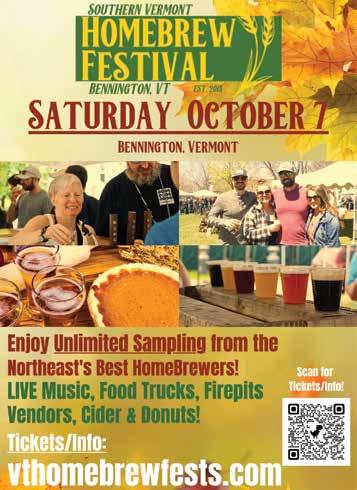




Two perfect dates
Miss Kitty’s guide to autumnal romance in Vermont
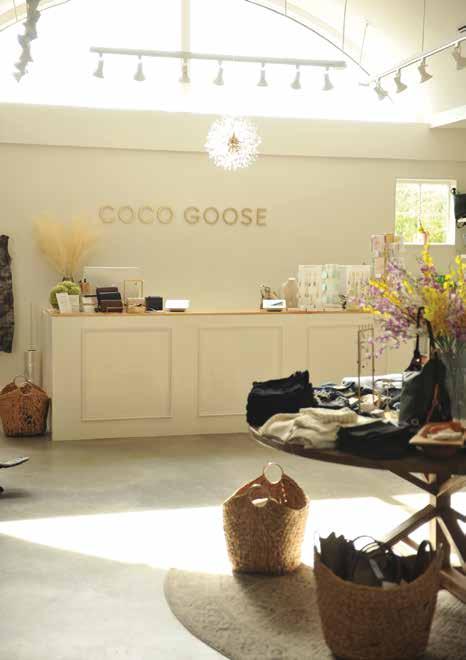
This Kitty is sure there is no more romantic a season in Vermont than fall. Whether a Kitty has been tethered to the same old Tomcat for years, or whether she has perhaps just suffered rejection from an ungrateful calico who, frankly, was not that good-looking anyway, the fiery foliage of autumn and tickle of brisk Vermont air will surely spark the Feast in her Fancy and the Fancy in her Feast.
That said, in a land where Carolina boots are considered “dress shoes” — in a state where “the odds are good, but the goods are odd” — a single Kitty may be challenged to find a suitable mate. For this reason, it is imperative she persevere through fall; before the great shadow of Jack Frost descends and she not only finds herself alone through those long winter nights but (even worse) unjustly forced to shovel her own front steps.
However, whether one is linked to their sphinx or still dancing the Bumble jumble, should they follow this Kitty’s infallible guide to the perfect Autumnal date, they will no doubt light the flame of romance, ensuring cozy December nights and a properly salted walkway.
When Miss Kitty gets all spooky sexy ...
Guilford: Begin Caturday date night with drinks and dinner at Green River Bridge Inn, a secret gem nestled deep in the woods alongside a glittering dam and red covered bridge. Inside this gorgeous colonial, enjoy the house specialty, Flammekuchen, a thin-crust German style pizza that is pawsatively the best pie in Southern Vermont. Outside the Inn, a Kitty and her Tomcat may curl up with a dry martini on
Photo provided
vermontcountry.com | 29
COCO GOOSE sells fabulous shoes, divine dresses and autumn cashmere. Oh my, what is a Kitty to do?

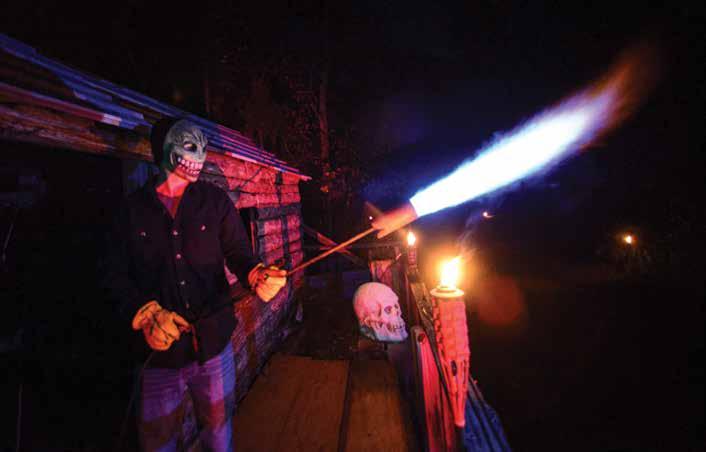 Kristopher Radder — Vermont Country
Kristopher Radder — Vermont Country
30 | VERMONT COUNTRY MAGAZINE | SEPTEMBER/OCTOBER 2023
The sounds of chainsaws and screams fill the air at Gaines Farm in Guilford, during the first night of Vengeance in the Valley in October 2022.
the veranda, serenaded by the Green River’s babble and the rustle of orange maples overhead. Even more thrilling is when night falls over this impossibly Norman Rockwell setting; shadows blur and it is not hard to imagine Ichabod Crane skulks the grounds ... Next up: After dinner, take a short drive to Gaines Farm where, during the month of October, farmers Bob and Jacqueline Gaines transform their property into a terrifying terrain of doom. (This Kitty thinks there is nothing like a cocktail of cortisol and adrenaline to put some spice in your mice!) Take a Haunted Hayride through the outlying woods where actors dressed as zombies, serial killers, and even Chucky's Bride leap from the trees with chainsaws and butcher knives. If a Kitty’s date is particularly handsome, she might even decide she is quite scared with all the fuss of roaring chainsaws and thus cling with fright to said date’s muscular thigh ... bad Kitty. The most chilling activity offered in October at Gaines Farm is the corn maze. With nothing but the moonlight to guide one’s steps, a Kitty may find herself quite lost amongst corn, heart a-thump with the knowledge that her worst nightmare may lurk around each corner. This Kitty will also point out that the corn maze may be too scary for the average Kitty, mostly because she heard about this one Kitty who really couldn’t handle
being chased through the corn by a pack of ax-wielding killer clowns, and so maybe had to ride the whole way home from Gaines Farm with wet underpants. Pure rumor, of course. Important to remember: The lines for both the hayride and corn maze are epic. If a Kitty wants to stay warm and entertained while also killing time, she may think to pack ahead, a small flask filled with Sapling Maple Bourbon, a divine whisky that just screams autumn in Ver-

When Missy Kitty has a sponsor (three meows!) ...
Manchester: If a Kitty has acquired a sponsor for the day, she must insist on an afternoon in Manchester, Vt., a town famed for wonderful restaurants and, yes Kitties, designer outlets! Oh, joyous are these occasions, though they require the utmost vigilance and strategy. This Kitty suggests one start their Tomcat off with a few luncheon cocktails as she finds a single malt or two will later make him exponentially more generous. Begin the afternoon at The Falcon Room in the Equinox Gulf Resort and Spa, a rambling hotel built in the late 18th century, boasting grand columns and stunning views. Gazing upon Mount Equinox, ablaze with fall brilliance, enjoy snacks and drinks on the Falcon Room’s sunny veranda until one is quite sure her Tomcat is feeling “whisky frisky.” Then
make a suggestion: Might Kitty do a little window shopping? This is go-time and not a moment should be wasted.
Step 1: Remember, one must initially lull the Tomcat into a false sense that he will not only enjoy shopping with Kitty, but that all kitties simply shop with the intent of pleasing their Tomcat. Baring this in mind, a Kitty’s first stop should be La Pêche Lingerie, which, with a coquettish smile, a Kitty will casually suggest (though naturally she will have called La Pêche ahead of time and made a fitting appointment for 2 p.m.). Tick-tock...
Step 2: A short fashion show in the dressing room of La Pêche will do. Allow the Tomcat to pick out a few ridiculous pieces of frilly dental floss
mont, and which is made at the Saxtons River Distillery in Brattleboro, just a 15-minute drive from Gaines Farm. Even more important to note: Gaines Farm has been run by the same family for eight generations — since 1782. Jackie and Bob Gaines have survived many hardships that destroy farmers in Vermont. The haunted hayrides and corn maze are a wonderful way to ensure local farms continue to thrive in the Green Mountains.
that he dreams a Kitty will wear each evening when she greets him at the door with a post-work cocktail, but that Kitty knows will likely get tossed in some random drawer with similar garments, never to be seen again. Nonetheless, after he deliberates for what seems like ages and eventually chooses the most hideous and no doubt untoward garment, this tiring but vital step will be done with.
Step 3: Implement Mission Designer Denim! COCO GOOSE is a one-stop boutique for the latest fall lines, sure to get a Kitty purring. For Denim, think Citizens, Mother, Z-Supply, Free People, Rails, Closed, L’Agence, Pistola, Frame, THE GREAT, Paige, Moussy ... Oh, Kitties, this glorious oasis of civility and fashion will make a Kitty feel as though she has finally come home! It also means she will want to
vermontcountry.com | 31
Kristopher Radder — Vermont Country
Once at COCO GOOSE, park your Tomcat with his cell phone at one of the lovely lounge chairs made specifically for such a purpose, then casually remind him that he missed the Buccaneers game last night. What was the score anyway? This emulsion of single-malt, lingerie and barbaric American tradition will likely buy a Kitty one or two hours, so make the best of it.
devote a large chunk of time at COCO GOOSE, and so must plan accordingly. Park your Tomcat with his cell phone at one of the lovely lounge chairs made specifically for such a purpose, then casually remind him that he missed the Buccaneers game last night. What was the score anyway? This emulsion of single-malt, lingerie and barbaric American tradition will likely buy a Kitty one or two hours, so make the best of it. COCO GOOSE also sells fabulous shoes, divine dresses and autumn cashmere. Oh my, what is a Kitty to do?
At this point, a Kitty’s mission will be completed, and she will find herself not only exhausted from her boutique sweep, but very thirsty. There is no more glamourous a spot for a postshop cocktail than The Silver Fork. In the heart of Manchester Village, this stunning restaurant and bar is built in the lofty setting of Manchester’s former Mark Skinner Library. A Kitty cannot impress how striking and unique the décor at The Silver Fork is. A flamboyant midcentury masterpiece of floor to ceiling windows and brilliant color, one feels as though they lounge in the co-creation of Frank Lloyd Wright and Jackson Pollock.
Note: Silver Fork does not open until 5 p.m., so one must extend the shopping experience until exactly 4:55. You can do this, Kitties!
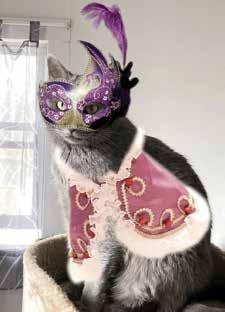

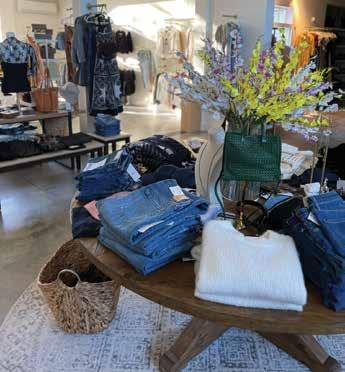
For dinner, there is any number of fabulous dining establishments in Manchester. If the Tomcat continues to throw back scotch, shoot high: Chop House at Equinox ($$$$). If he seems to still enjoy himself but maybe scrutinized the bill at Silver Fork a little too closely, go for The Foundry ($$$). If he becomes irritable and starts sifting through your shopping bags to look for receipts, suggest Thai Basil ($$). In any case, all the above restaurants are Kitty faves that shall not disappoint. When both parties return home from Manchester, a Kitty will, no doubt, be running on the thrill of newly purchased overprice denim, whereas the Tomcat, with any luck, shall simply pass out. However, if both parties appear enlivened by their autumn day in Manchester, well, a little dental floss never hurt a Kitty ...
This Kitty hopes her guide has been helpful to both felines on the prowl as well as those hoping to light a nibble in their preexisting kibble. Regardless, if a Kitty follows these tips for the per-
fect autumn date, she shall rest assured that the beloved burning bush of our Green Mountain State shall not be the only thing that smolders for her this harvest season.
As usual, Kitties, be good, drink well, and be thankful you are not camping!
Xoxoxo Miss Kitty
Photos provided
32 | VERMONT COUNTRY MAGAZINE | SEPTEMBER/OCTOBER 2023
Check out Southern Vermont’s most exclusive homes for sale and the top-notch Realtors and agents who represent them.
See our ads on pages 34-35
 Photo courtesy of Brattleboro Area Realty
Photo courtesy of Brattleboro Area Realty
Sponsored Content vermontcountry.com | 33

34 | VERMONT COUNTRY MAGAZINE | SEPTEMBER/OCTOBER 2023 Sponsored Content
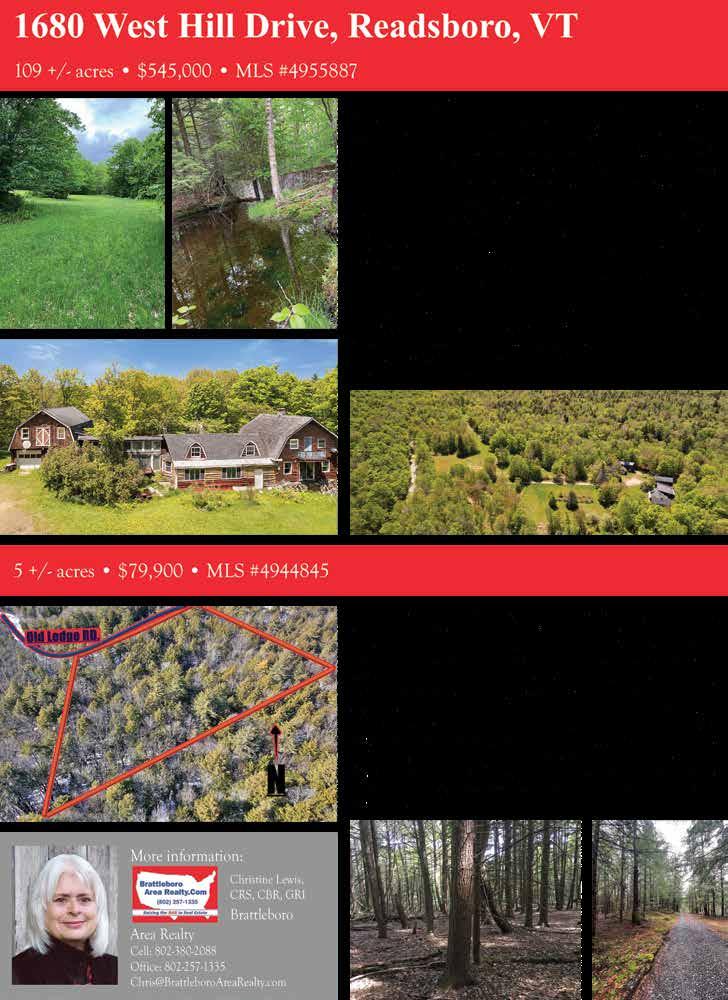
Sponsored Content vermontcountry.com | 35

36 | VERMONT COUNTRY MAGAZINE | SEPTEMBER/OCTOBER 2023 Sponsored Content

Sponsored Content vermontcountry.com | 37





A look at local
As previously published on
By Jennifer Brandt and Tory Rich
The Vermont Bud Barn
BRATTLEBORO — When Scott Sparks opened Vermont Hempicurean in 2018 in downtown Brattleboro, it was a crucial step in his long-term cannabis business strategy. Establishing a respected business beforehand would prove advantageous once cannabis became legalized. When the legalization measure finally reached the ballot, Scott garnered nearly unanimous support from both the Brattleboro Selectboard and the Planning Commission.
Sparks has expanded his operations since relocating from downtown Brattleboro to a big red barn at 257 Marlboro Road in West Brattleboro, which houses The Vermont Bud Barn, offering CBD products for humans and animals, and legal adult cannabis products for retail; The Vermont Grow Barn, catering to home growers; and soon — In The Weeds, Vermont Hempicurean's indoor cannabis cultivation facility.

Sparks aims for his company to embody Vermont's community-minded spirit. He revels in the joy of making people happy and appreciates the diverse mix of tourists and locals who walk through his door daily. He hopes to host concerts and events on the barn lawn in the future. Presently, a Jamaican food truck awaits right in the parking lot, offering munchie options after shopping. Don't hesitate to stop by and say hello — you'll be glad you did.
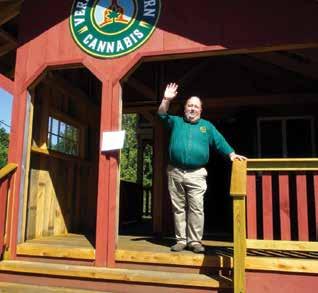
Read more at greenmountaincannabisnews.com.


 Photo provided by Craft State Media
Owner Scott Sparks at Vermont Bud Barn.
Kristopher Radder — Vermont Country Scott Smith, of Brattleboro, smells some of the cannabis that was on display at the Bud Barn during its opening day on Oct. 24, 2022.
Photo provided by Craft State Media
Owner Scott Sparks at Vermont Bud Barn.
Kristopher Radder — Vermont Country Scott Smith, of Brattleboro, smells some of the cannabis that was on display at the Bud Barn during its opening day on Oct. 24, 2022.
GreenMountainCannabisNews.com @GreenMountainVermont
40 | VERMONT COUNTRY MAGAZINE | SEPTEMBER/OCTOBER 2023
fall 'greenery'
Kingdom Kind
BARTON — What drew Karen Devereux of Kingdom Kind into the cannabis industry were the practical health benefits. Her mother struggled with pain issues in the past and had not found an effective solution. The more Karen learned about cannabis, the more she became convinced of its potential.
Devereux envisions a future where cannabis products hold the same status as other high-end and value-added Vermont products, such as cheese, maple syrup and beer. Kingdom Kind employs both indoor and outdoor cultivation methods, ensuring that all cannabis sold is meticulously hand-trimmed and personally approved by master grower Cam Devereux before it is packaged.


"It always comes back to the farmer. It comes back to my husband and my sons. The consumer may want more products produced faster and cheaper, but we always come back to our dedication to producing a superior craft product," Karen explained.
Vermont Kind Cultivation and Manufacturing originated from NEK Hemp, and Kingdom Kind serves as its dispensary. Kingdom Kind is grateful for the warm reception it has received from the community. Being a vertically integrated company, the owners take pride in controlling the quality of every product they grow and manufacture, ensuring that only the best items make their way onto the store shelves.
Read more at greenmountaincannabis news.com.
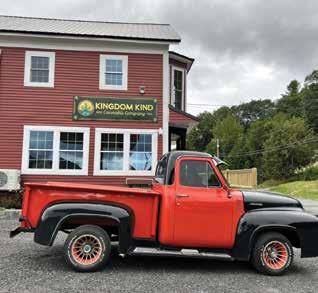 Provided photo Kingdom Kind as viewed from 290 Glover Road, in Barton.
Kingdom Kind, viewed from the inside register. Provided photo
Provided photo Kingdom Kind as viewed from 290 Glover Road, in Barton.
Kingdom Kind, viewed from the inside register. Provided photo
vermontcountry.com | 41
Juniper Lane

BENNINGTON — Colleen McQuade took a giant leap, both personally and for the cannabis industry in Vermont, when she opened Bennington’s first retail cannabis shop last October, Juniper Lane. Now, with the help of some friends, she's fulfilling another goal of branching out into cultivation.
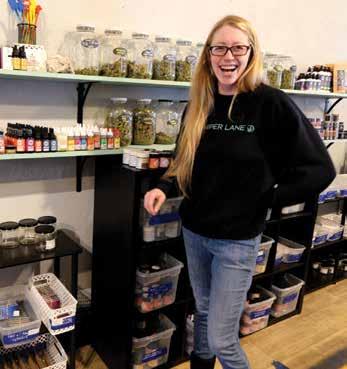
McQuade acquired her Tier 1 mixed use cultivation license in late May.

“Cultivation was something I’ve always been wanting to do,” she explained. “But what fast-forwarded the timeline for me a little bit this year was that me and two of my friends started a co-op."
McQuade's partners in the co-op wish to remain anonymous for the time being, but she was sure to mention their support was instrumental.
“It allows us to do things like pool resources, like when we had to put up all of our fencing. Things I would have never been able to pull off as just me,” she said. “It was really nice. The three of us have really worked hard over the last few months to get this off the ground.”
McQuade said cannabis co-ops, as far as she can tell, are a relatively new concept, especially on the East Coast, and might serve as a model for cultivators to follow in the future.
In addition to passing on savings to her customers, McQuade says being able to grow her own product will allow for closer monitoring and quality control of her product, and will lend itself to the consistency customers hope for.
“It stinks when you really start liking something and you’re like, ‘Oh, that one strain really works for me,’ and then you never see it again or it’s months before it comes back into stock,” she said.
Read more at greenmountaincannabisnews.com.
Tory Rich — Vermont Country Juniper Lane as seen from Main Street in Bennington.
Subscribe to GreenMountain Cannabis News, a free weekly newsletter that provides you with the latest updates and insights. Visit GreenMountainCannabisNews.com to subscribe and stay informed. 42 | VERMONT COUNTRY MAGAZINE | SEPTEMBER/OCTOBER 2023
Stewart Cairns — Vermont Country Colleen McQuade, owner of Juniper Lane Cannabis Dispensary in Bennington, shows off some of her products.




The haunting of Glastenbury Mountain
Hike the Bennington Triangle ... if you dare
By Bob Audette
Vermont Country
GLASTENBURY MOUNTAIN
— Joseph Citro doesn't want to scare you away from exploring the vanished town of Fayville, but he has one piece of advice for intrepid hikers.
"I tell people be careful up there and don't go alone," said Citro, who coined the term "The Bennington Triangle" in 1992. "It's not the most inhospitable terrain in the state, but it's pretty easy
to get lost or hurt up there."
Northeast of Bennington, the area around Glastenbury Mountain, at 3,747 feet, covers roughly 36 square miles of unbroken wilderness and includes the ghost towns of Fayville, Glastenbury and the almost-ghost-town of Somerset, with only six residents.
"The area is really creepy," said Citro, the author of "Weird New England," "The Vermont Ghost Guide" and "Lake Monsters."
"I went up there with a forester, so I was in good hands and I felt pretty safe with him, but I don't know if I'd want to go wandering around up there alone," he said.
Citro was drawn to the area by reports of missing people between the years of 1945 and 1950, including Paula Welden, a sophomore at Bennington College who disappeared in the area while hiking the Long Trail in 1946. Hundreds of people were involved in the search for Welden, including law enforcement, family members, the FBI, the National Guard and volunteer firefighters. Following criticism by Welden's family, the Vermont Legislature created the Vermont State Police.
Shirley Jackson, author of "The Haunting of Hill House," which she wrote while living in North Bennington, also
wrote "Hangsaman," loosely based on the disappearance of Welden.
"The oldest accounts that I could find of what I called the Bennington Triangle is that Glastenbury Mountain was kind of a shunned place," said Citro, with colonists reporting indigenous stories of "a human eating rock" on the mountain.

"Even the earliest colonists reported strange lights, eerie sounds and unidentifiable odors," said Citro. "Some
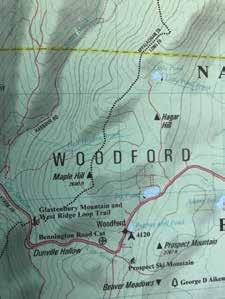 Image provided by Roberta Stone
A map of the Bennington Triangle.
Image provided by Roberta Stone
Image provided by Roberta Stone
A map of the Bennington Triangle.
Image provided by Roberta Stone
44 | VERMONT COUNTRY MAGAZINE | SEPTEMBER/OCTOBER 2023
A map of the Bennington Triangle.
families there swear their ancestors actually encountered monstrous animals — prehistoric or preternatural — along the wooded paths or deep in the undeveloped woodland."
Welden's disappearance wasn't the only one to confound authorities and to creep out locals and visitors and hikers in the region.
The first recorded disappearance was Middie Rivers, a 75-year-old hunting and fishing guide who got ahead of
four hunters he was leading down from Glastenbury Mountain in late 1945 and was never seen again. A year later, Welden disappeared. In 1949, Jim Tetford had been visiting relatives in St. Albans and was returning to Bennington by bus. Witnesses saw him get on the bus, but no one saw him get off. In 1950, 8-year-old Paul Jepson disappeared during a trip with his mother to a local landfill. Two weeks later, Freida Langer was hiking with her cousin on Glastenbury Mountain, an area with which she was thoroughly familiar. After Langer fell in a stream and rushed home for dry clothes, she was never seen again. Just a few days later, Frances Christman went for a brief hike and also disappeared without a trace. And then, in November that same year, 16-year-old Martha Jeannette Jones was reported missing after hitchhiking to seminary school in Manchester.
"It's a community that keeps those stories alive," said Joe Belanger, author of "The Encyclopedia of Haunted Places" and the host, with Ray Auger, of "The New England Legends Podcast."
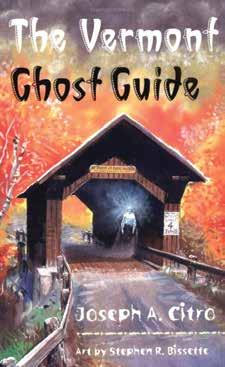

"Whether you believe in ghosts or not, all these legends exist because a community created them based on something," said Belanger. "In the case of the Bennington Triangle, you've got Glastenbury Mountain and you've got a ghost town up there and you've got people that have disappeared and gone missing."
Belanger, who said he's heard stories of monsters lurking in the Vermont mountains but never actually seen one, said legends and scary stories serve us in some way, whether it's to remind us to be safe in the woods or that sometimes people go missing.
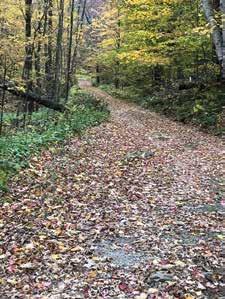
"The Bennington Triangle stories are a reminder if you go hiking in those woods, if you want to hike the Long Trail, not everyone survives that," he said. "That's true today. People have heart attacks, people die of exposure, all kinds of things. It's a reminder that there are dangers out there and people do vanish. And so maybe take a little extra care if you're going to be wandering through areas that are that remote."
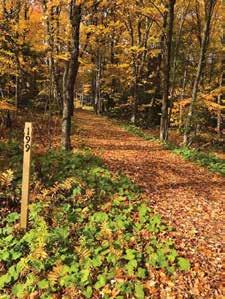 Photo provided by Roberta Stone
A trail in the Bennington Triangle.
Photo provided by Roberta Stone
A trail in the Bennington Triangle.
Photo provided by Roberta Stone
A trail in the Bennington Triangle.
Photo provided by Roberta Stone
A trail in the Bennington Triangle.
vermontcountry.com | 45
Images provided Joseph Citro, who coined the term "The Bennington Triangle" in 1992, is author of "Weird New England," and "The Vermont Ghost Guide," among other titles.
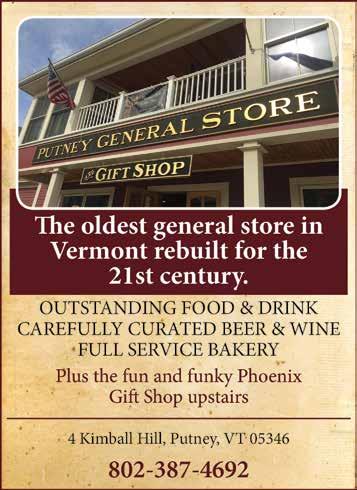


Natural materials, real stories
In North Bennington, Michelle Samour talks about paper like we’ve never seen before
 Michelle Samour talks about her work at her studio in North Bennington.
Michelle Samour talks about her work at her studio in North Bennington.
vermontcountry.com | 47
Stewart Cairns — Vermont Country
By Gena Mangiaratti Vermont Country
NORTH BENNINGTON — It could be said that Michelle Samour’s art begins on the molecular level. In her studio in North Bennington, she walked Vermont News & Media through the process of papermaking, from fiber to pulp to drying into molds or sheets or other shapes that resemble the natural world. The shapes and textures that adorn her studio walls call to mind plants, mushrooms, and unidentifiable specimens one might find under a microscope (which she also has in her studio).
“When you’re working with paper, you’re part cook, and you’re part scientist,” Samour said. “There are measurements. There’s understanding the chemistry. There’s a lot of chemistry involved. Not only am I telling stories about the natural world and the biologic world, I am using materials that come from that world.”
Samour is a nationally-recognized interdisciplinary artist whose work incorporates painting, drawing, collage and more. Her paintings summon insects, microorganisms and Persian rugs. On her website, there are photos from a series called “Borders and Boundaries,” inspired by her Palestinian heritage. The series includes a piece that, using acrylic Mother of Pearl and paper pulp, depicts the shapes of Israel, Palestinian territories and encroaching settlements as biological specimens.
“It’s talking about borders and boundaries, the potential for movement and relating that to biology and biologic form,” she said.
In a book of drawings in her studio, her finely detailed works incorporate various elements of nature: a bird with leaves for wings, mating snails from which sprout what appears to be an aquatic plant formation, and other images that are surreal but don’t seem that far-fetched.
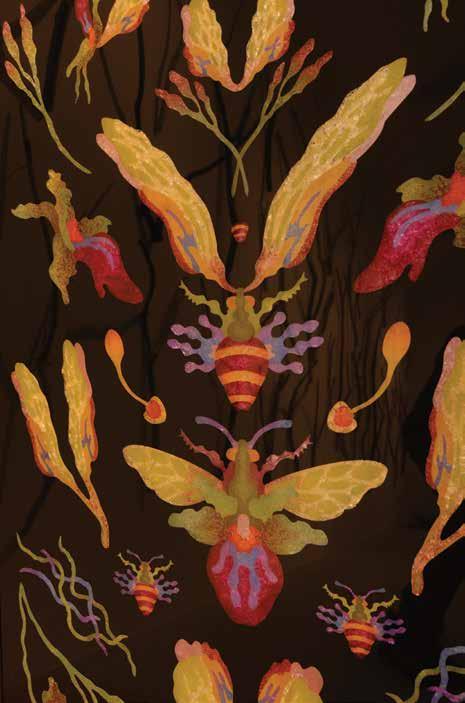
Samour moved to Bennington from the Boston area two years ago, and her studio, adjacent to the Bennington College campus, was built over a year ago.
“What was surprising was that when we moved here, I hadn’t realized that Bennington had a real connection to
the paper industry,” she said. Local history includes the artist Ken Noland, who worked with colored paper pulp in a converted barn studio near the Park-McCullough house, and the Stark Paper Mill, which was down the street from Samour’s studio.
Samour took the time to not only give a demonstration of her process, but talk about how she got into papermaking, how her family inspired her, and how her work captures the collision of
science, human rights and curiosity.
Q: The themes of biology and human rights are consistent in your work. Can you talk about how this came to be?
A: Part of that interest has to do with the fact that my father was a research chemist. So having grown up with him, taking trips to the lab. He’d do little experiments with us. My parents were also really interested in the natural world. My mother’s side of the family
48 | VERMONT COUNTRY MAGAZINE | SEPTEMBER/OCTOBER 2023
Stewart Cairns — Vermont Country Work by Michelle Samour at her studio in North Bennington.
was French and my French grandmother lived with us. I remember going out and hunting for mushrooms at a young age and picking watercress. My father’s side of the family was Palestinian. I remember as a child asking him, when he told me that our family was Palestinian, I asked him to show me that on the globe, and he said it’s not there; it’s now Israel. I could not wrap my mind around that.
So over the years, I studied a little bit more about that area of the world. I thought that at some point I wanted to address that part of my heritage, didn’t know quite how to do it. I wanted it to be real honest. I wanted to take a really honest approach to telling that story. So I started, maybe seven years ago or so, working with different media to talk about the Palestinian story. The section on my website, “Borders and Boundaries,” talks all about that. There was a strong family influence. And I think I’m just the kind of person, too, that likes to dive into things,
and sort of, looking at the biologic world, what lies beyond the surface of something. Thinking about cellular structure, how something is formed, how something is constructed and built, that just has always intrigued me.
Q: You have described your role as a papermaker as “part cook, part scientist.” Can you talk about what it is like to work in this medium?
A: I just love getting my hands into pulp. Some people, when they look at the cooked fiber, like, “Oooh” (shudders). Most of my students, I would say, 99 percent of my students, for instance, love putting their hands in the pulp and cooking it and smelling it. But every once in a while, there would be someone who would touch it and I would just know that they were just not going to be coming back to the next class.
But that was very rare, because most people are totally seduced by the process of making paper. I still consider it to be very magical, very challenging,
always surprises, always something new to learn. Despite the fact that I’ve worked with it for over 40 years, I’m always learning something new. I’m never bored with it.
And I appreciate the physicality of it. It’s such an immersive way of working. I sometimes think about it, like working with clay, except that you know, with clay, you put it in the kiln. With paper, you put it in the drying box, and it changes when it dries, so you don’t quite know what you’re gonna get until it’s fully dried, until you’ve finished working with it. But it is a lot lighter than clay.
Q: How did you get into papermaking?
A: My first exposure to paper was as a child. My father brought me to MIT, where he had gone to school. There were some models that were made by Dard Hunter, who was a papermaker. He was really responsible in the West for bringing the knowledge of hand papermaking to people. I mean, he did a lot of research on
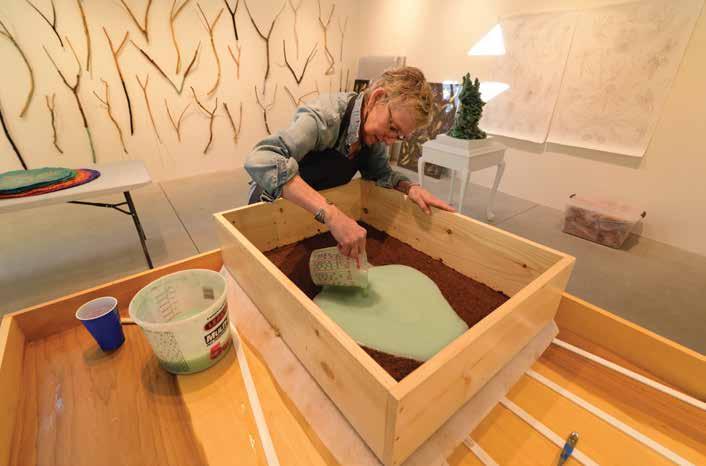 Stewart Cairns — Vermont Country
Stewart Cairns — Vermont Country
vermontcountry.com | 49
Michelle Samour shows some insight into her creative process at her studio in North Bennington.

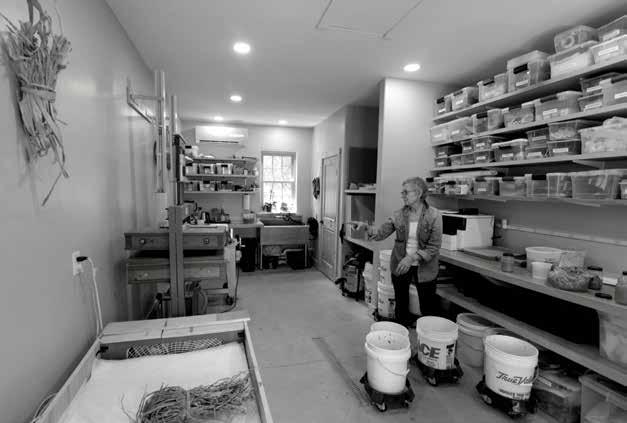

50 | VERMONT COUNTRY MAGAZINE | SEPTEMBER/OCTOBER 2023
Stewart Cairns — Vermont Country

 This spread, bottom left: Michelle Samour shows the features of her studio in North Bennington.
This spread, bottom left: Michelle Samour shows the features of her studio in North Bennington.
vermontcountry.com | 51
Clockwise from top left: Work by artist Michelle Samour at her studio.
Eastern papermaking and Western papermaking and wrote about the history of paper making. Anyway, he had made these beautiful, intricate models. And I remember vaguely, I mean, I was really a little kid when I saw them, but they stuck in my my mind. Then, in junior high school I did a paper on papermaking. I’m assuming it was for a science class. I don’t remember. But I remember just being totally taken with the idea that you could make it. I mean, we use paper all the time. We touch paper constantly. But rarely do we think about how it’s made and where it comes from.
I mean it is again, the paper tied back to plant matter because it is plants. So then, I was doing some collage work after finishing art school, and I was taping materials onto some heavyweight paper, but the paper was still buckling. So I started recycling paper and embedding the materials into the paper. That was the first time that I actually had used it in my artwork.
And that was a real revelation. It just started all of my interest really and using it as an art form. And at that time in the that was in the mid-’70s. It was really, a very new medium for artists, and artists were gathering around the country sharing ideas. There was very little being taught on the college level. So we would all gather and share information, and it grew from there.
Q: You’re working on a book with coauthor Lynn Sures. What is the book about?
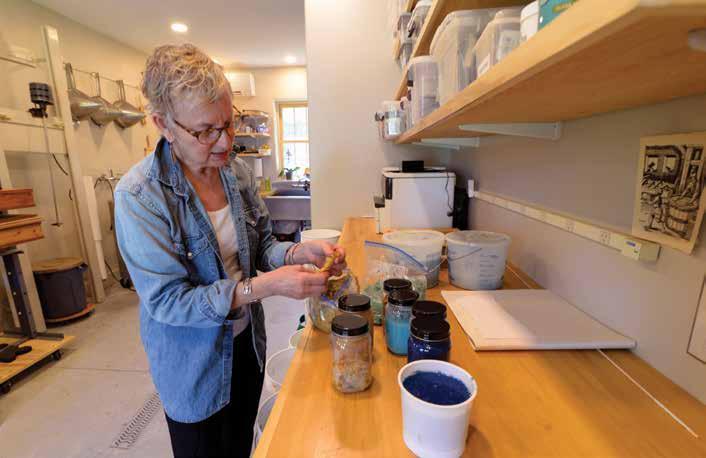
A: It’s about papermaking as an art form, and it’s about the history of artists who have really, radically changed how we think about paper as a substrate. So: these artists, looking at history, and looking at the contemporary work — there will be a lot of contemporary work in the book, as well, of artists who are using it as a primary medium.
It’s very exciting. There have been other
books that have touched on this in different ways, but ours will be something different. It’s such an exciting medium. One of the reasons to do it, too, for us, was that not that many people know that much about paper.
If you look at any of my work — well, if I don’t tell you about it, I wouldn’t imagine if you just saw this [gestures to her work], that you’d know exactly what it was, right? And that’s what I love about it, too, is that people expect paper to look like what they think paper should look like, which means paper that they’ve drawn on, or maybe it’s fine art paper. But when it looks like something else, people, they don’t know what they’re looking at. We want to inform people and get them excited about this medium, and share what other people have been doing with this medium for 60-plus years as an art form.
For more information about Samour and her art, visit her website, michellesamour.com.
Stewart Cairns — Vermont Country
52 | VERMONT COUNTRY MAGAZINE | SEPTEMBER/OCTOBER 2023
Michelle Samour shows some of the resources that are used to create her art at her studio in North Bennington.



Something’s always out there
10 tales of woodsy terror
By Dan Tebo
In Lars von Trier’s aggressively unpleasant horror film “Antichrist,” Willem Dafoe’s nameless character asks his nameless wife (Charlotte Gainsbourg) what scares her most about the woods. Her answer: everything. Therein lies the great paradox of an area that is, by every metric available, the safest place one can find oneself. A lot of rational people, particularly us New Englanders raised on a steady diet of Stephen King, are irrationally terrified of the woods.
While it’s certainly reasonable to fear the woods for actual earthen concerns like severe weather and four-legged predators, forest phobias are more likely to involve the fantastical and the supernatural. It’s the movies, of course, that have infected us with the idea that the sound of a snapped twig in a dark, moonless forest always signals the approach of a homicidal maniac, witch, alien, or what have you. This month, we’re going to discuss 10 films where the woods are the place where we’re guaranteed to confront our greatest fears.
Evil Dead (1981): Sam Raimi was all of 20 years old when he brought Bruce Campbell and an Oldsmobile full of pals to a Tennessee cabin to shoot this groundbreaking gore-a-thon that can still churn a stomach 40 years later. Hell, in this film, even the light sockets gush blood!
Watcher in the Woods (1980): A family of American expats moves into a creaky mansion in the English countryside and is preyed upon by the ghost of a young girl who disappeared 30 years earlier. People were so upset at Disney for making this queasy thriller, they were forced to pull it from theaters and edit it into incomprehensibility. Co-starring Bette Davis of “Bette Davis Eyes” fame.
Friday the 13th Part VI: Jason Lives (1986): The biggest rock

54 | VERMONT COUNTRY MAGAZINE | SEPTEMBER/OCTOBER 2023
star of the 1980s was a mute, maggot-encrusted zombie in an antiquated hockey mask named Jason Voorhees with a penchant for butchering fornicating teenagers ... preferably in wooded areas. Why Part 6 you ask? Really, why not? You'll get similar mileage out of any “Friday” film.
The Blair Witch Project (1999): This reviewer maintains that this pioneering found footage thriller about a trio of fledgling filmmakers marooned in the Pennsylvania wilderness is still scary as all get out. Even scarier? The fact that a lot of people originally thought this film was non-fiction. The internet wasn’t THAT slow in 1999!
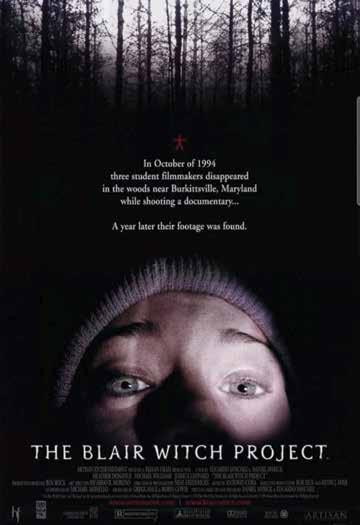
Cabin Fever (2002): Massachusetts native Eli Roth debuted with this blood curdler about a group of college students being stalked by a flesh eating virus at, you guessed it, a remote cabin in the woods. Roth balanced the heavy bloodletting with the sort of gallows humor and Lynchian flourishes that have been absent from every film he’s made since.
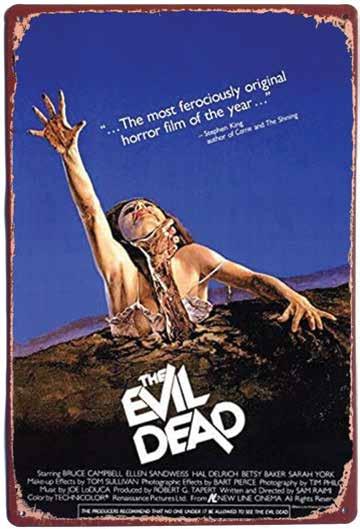
Baghead (2008): Mumblecore made a rare detour into horror with this medium scary film about a group of aspiring screenwriters being hunted by a figure with a bag on its head while they sit around a cabin and casually shoot the breeze. Directed by the Duplass Brothers and featuring Greta Gerwig, who all went on to be various stripes of extremely famous.
Antichrist (2009): Following the death of their infant son, a profoundly bereaved couple retreat to a remote cabin to try
vermontcountry.com | 55
to work through their grief. As this is a Lars von Trier joint, that process includes reams of pretentious dialogue, unsimulated intercourse, grisly violence, and a talking fox. One of von Trier’s least digestible films … and that’s saying something.
The Witch (2015): Robert Eggers arrived fully formed with this deeply disquieting grayscale folk horror film. In 1630s New England, a family is cast out of a Puritan village and forced to live in the woods, where it is beset by disappearing children, internal religious hysteria, and a threatening black goat with the decidedly nonthreatening name Black Phillip.
The Rental (2020): Horror movie rule of thumb: If a vacation rental seems too good to be true, everyone in the movie will die slowly. Non-problematic Franco brother Dave Franco directed this effective thriller about two couples who travel to a secluded beach house to take drugs and engage in extremely predictable relationship shenanigans while being stalked by a casually racist Airbnb host.

Knock at the Cabin (2023): Perennial Vermont Country magazine punching bag M. Night Shyamalan adapted Paul Tremblay’s novel about a couple and their 7 year-old daughter being terrorized by a doomsday cult at the titular cabin. The cult claims that the apocalypse will occur if the family won’t sacrifice a member and, spoiler alert, they ain’t joshing! A rare twist-less ending from the master of twist endings.
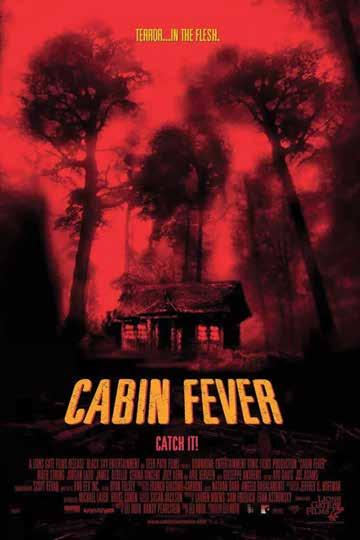
56 | VERMONT COUNTRY MAGAZINE | SEPTEMBER/OCTOBER 2023




























 By Robyn Jensen
By Robyn Jensen
 By Gordon Dossett
By Gordon Dossett

 By Bob Audette
By Bob Audette

















 By Michael Albans Vermont Country
By Michael Albans Vermont Country

 Michael Albans — Vermont Country
Michael Albans — Vermont Country






















 Kristopher Radder — Vermont Country
Kristopher Radder — Vermont Country




 Photo courtesy of Brattleboro Area Realty
Photo courtesy of Brattleboro Area Realty













 Photo provided by Craft State Media
Owner Scott Sparks at Vermont Bud Barn.
Kristopher Radder — Vermont Country Scott Smith, of Brattleboro, smells some of the cannabis that was on display at the Bud Barn during its opening day on Oct. 24, 2022.
Photo provided by Craft State Media
Owner Scott Sparks at Vermont Bud Barn.
Kristopher Radder — Vermont Country Scott Smith, of Brattleboro, smells some of the cannabis that was on display at the Bud Barn during its opening day on Oct. 24, 2022.


 Provided photo Kingdom Kind as viewed from 290 Glover Road, in Barton.
Kingdom Kind, viewed from the inside register. Provided photo
Provided photo Kingdom Kind as viewed from 290 Glover Road, in Barton.
Kingdom Kind, viewed from the inside register. Provided photo








 Image provided by Roberta Stone
A map of the Bennington Triangle.
Image provided by Roberta Stone
Image provided by Roberta Stone
A map of the Bennington Triangle.
Image provided by Roberta Stone



 Photo provided by Roberta Stone
A trail in the Bennington Triangle.
Photo provided by Roberta Stone
A trail in the Bennington Triangle.
Photo provided by Roberta Stone
A trail in the Bennington Triangle.
Photo provided by Roberta Stone
A trail in the Bennington Triangle.



 Michelle Samour talks about her work at her studio in North Bennington.
Michelle Samour talks about her work at her studio in North Bennington.

 Stewart Cairns — Vermont Country
Stewart Cairns — Vermont Country




 This spread, bottom left: Michelle Samour shows the features of her studio in North Bennington.
This spread, bottom left: Michelle Samour shows the features of her studio in North Bennington.










